Global Perspectives Converge in Sun Valley
by Sabina Dana Plasse
Transplants and born-and-raised Sun Valley residents alike know it’s a magical place. In addition to access to world-class skiing, rivers, trails, and outdoor pursuits, Sun Valley also cultivates artistry. What makes the art scene here so exciting is that while there is a strong sense of community and local perspective, there is also an open-mindedness for drawing influences from the global scene. This season, Western Home Journal is pleased to offer a survey of fine art in Sun Valley, from concrete art to bamboo sculpture, abstract expressionism to atmospheric landscape. We hope you find these stories as interesting as we do and that you are inspired to bring some of the work into your own homes.
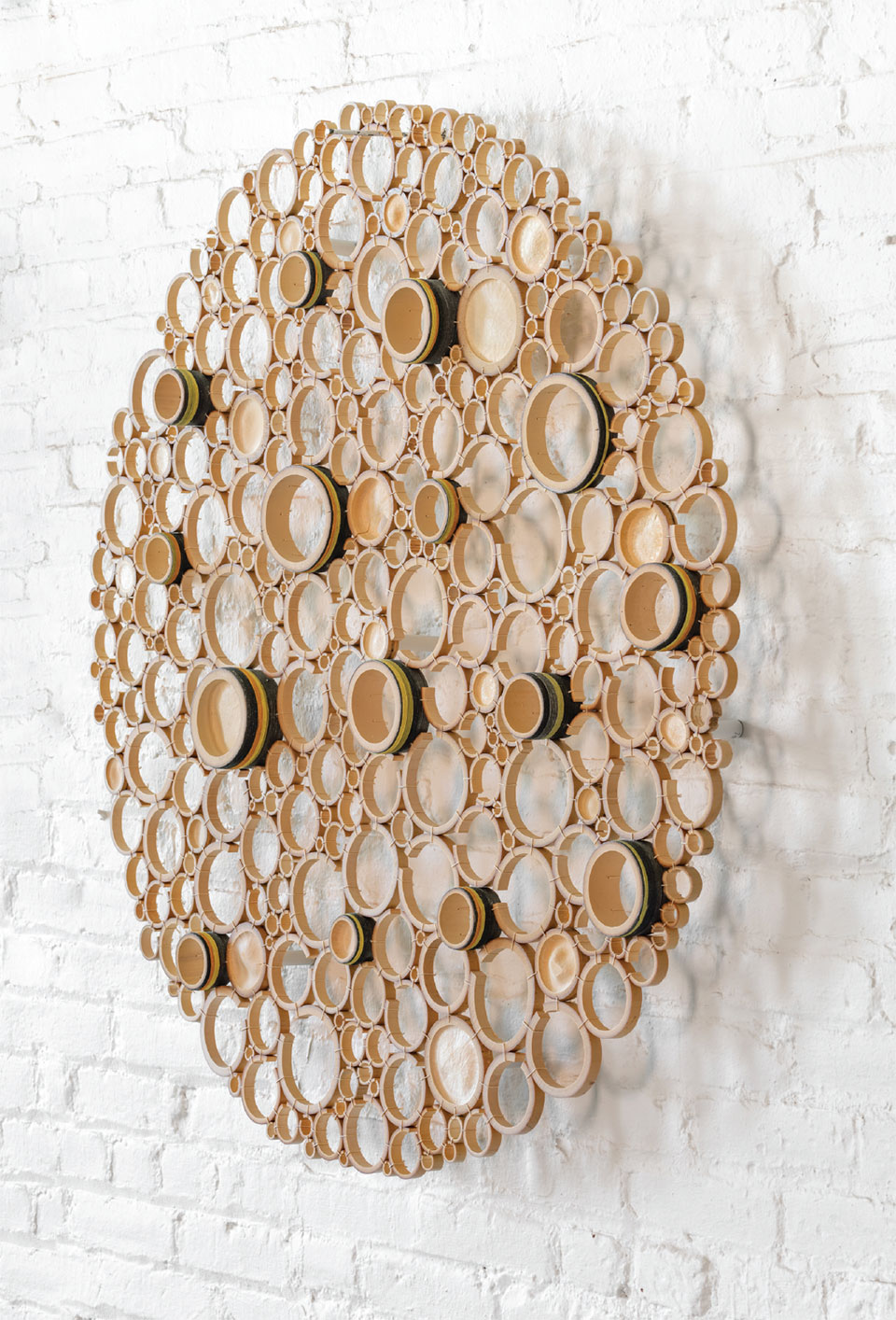
Ensō: Peloton Ride | 42” x 7” | crosscut bamboo and Irish waxed linen thread
The Enchanting Bamboo Art of
Anne Crumpacker
by Sabina Dana Plasse
When delving into Anne Crumpacker’s bamboo art, one discovers an interplay of life force and unity. Bamboo’s spherical and cellular composition encapsulates thousands of years of nature and the spirit of serenity, which Crumpacker harnesses into beautiful circular compositions. Held together through a vast network of hand-tied knots of Irish waxed linen thread, often in a variety of colors, each piece Crumpacker creates holds meaning that is visible from every angle.
“I start with full culms of bamboo wrapped with masking tape to protect the skin,” says Crumpacker. “I have a highly skilled carpenter who assists me in cutting who uses a blade with 16 teeth per inch for a clean cut. Once the masking tape is removed, I use a lavender lotion to wax the rings, giving it a patina and bringing out the bamboo’s cellular structure. I then tie and connect the rings with Irish wax linen thread. I knot on the back, wrapping around once or sometimes three times depending on the ply/thickness of the colored thread. Bamboo is an awe-inspiring material with an incredible texture, bringing serenity to any space.”
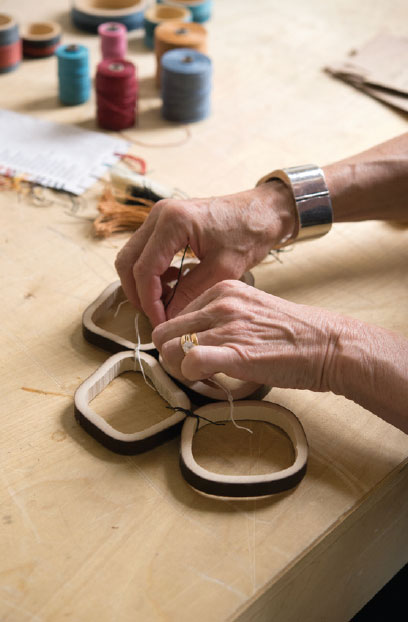
“It took a long time to call myself an artist, and there is something deep-seated and satisfying that adds meaning to one’s life in working with one’s hands. I have been making things with my hands my entire life. It’s been a lifelong journey.”
–Anne Crumpacker
Crumpacker’s commissions can be viewed around the globe, from the entrance of the Hard Rock Hotel in the Maldives to public spaces in and around Portland. She has been part of numerous exhibitions, including the Portland Japanese Garden, the Portland International Airport, and the Museum of Contemporary Craft in Portland.
Throughout Sun Valley, her work exists in private residences and has often been part of Friedman Memorial Airport exhibitions. The former Gallery DeNovo in Ketchum exhibited Crumpacker’s work. A recent work in a Sun Valley Elkhorn home is an intriguing commission made with crosscut bamboo, painted black, with silver leaf interspersed, and, for Crumpacker, an accomplishment she is proud to have created.
Crumpacker traces her connection with bamboo to a trip she took to Japan more than 30 years ago. She visited a freshly cut bamboo installation by artist and filmmaker Hiroshi Teshigahara who formed a Zen-like sanctuary with 40-foot arched culms (columns). It was a visceral moment of transformation during which she connected to something much more significant than herself.
“The interconnectedness of the circle as a universal and enduring symbol is eternal,” Crumpacker says. “Bamboo has been used in many cultures for thousands of years, and there is an intrinsic connection between people and bamboo.”
“Bamboo has enchanted me, as it has artists and artisans for thousands of years,” she continues. “It took a long time to call myself an artist, and there is something deep-seated and meaningful in working with one’s hands. I have been making things with my hands my entire life.”
Having grown up in the Northwest and based in Portland, Oregon, where Crumpacker has her studio, she has a connection to Sun Valley as the place where her family gathers, at their Sun Valley family home for decades. “It’s one of the most nurturing environments to be in,” she says. “My husband hails from several generations of family in Oregon, and my studio in downtown Portland is a family-owned space in a historic building built in 1872 that my father renovated in the 1960s. It’s on the waterfront and has always been a place I relish. I am fortunate to work in a space with my father’s history where the architecture and the brick walls provide a richly supportive environment to me.”
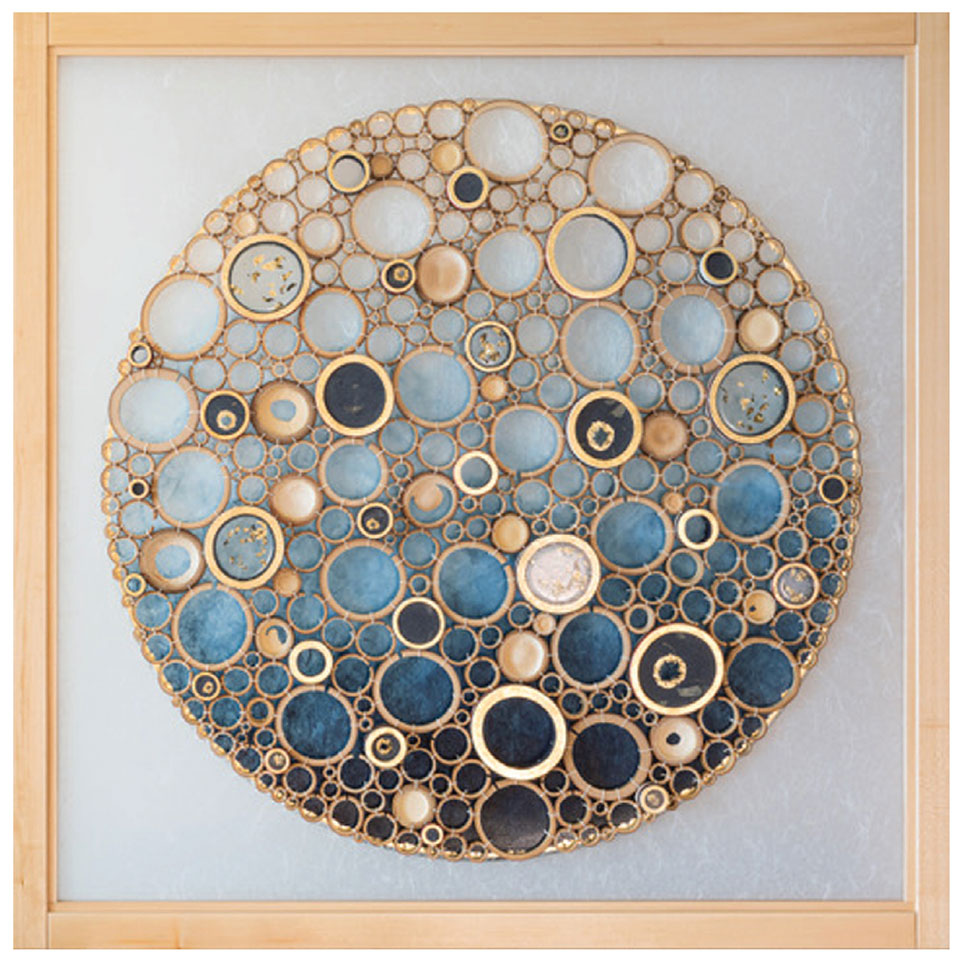
Ensō: Starry Starry Night | 39” x 2 ¼” | crosscut bamboo, Irish waxed linen thread, Korean rice paper, watercolor, Japanese acrylic/rice pattern, epoxy resin, gold leaf, and Shoji frame
“Color is also essential to me, and I have a few pieces of Japanese acrylic made to look like rice paper, which I have incorporated into my art, adding a nice dimension. When I was last in Japan, I also visited the Itoyo stationery store in Tokyo to look for paper and find available patterns. I used the paper as a backdrop and mounted the piece onto a board. It has brought me to another exploration, including a Japanese color pattern.”
–Anne Crumpacker
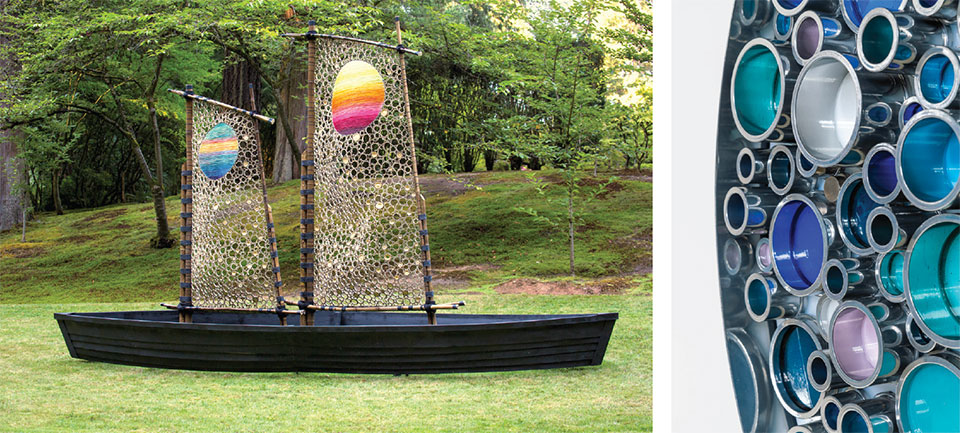
Left: Ukifune – Floating Boat | 20’ x 12.5’ | bamboo, crosscut bamboo, Irish waxed linen thread, acrylic, wood Portland Japanese Garden 2016.
Right: Ensō Luminary: Lighthouse – Beacon of Hope Detail | 40” x 6” | powder-coated aluminum plates, rings, and stainless steel; fused glass, LED lighting.
When Crumpacker completed her MFA and began to work in bamboo, she met Jimin Lee, who became her studio assistant and an integral part of her creative practice for more than 13 years. Lee collaborates with Crumpacker for bamboo design and creation, which is Crumpacker’s primary medium. However, powder-coated aluminum and glass luminaries are a new medium for them, carrying the bamboo aesthetic of spherical serenity. Crumpacker’s process is guided by Japanese aesthetics and she titles the circular works of art, Ensōs, referencing Zen design.
As an emerging artist, Crumpacker was told bamboo was ubiquitous and was posed the question by a mentor of how she would figure out what to bring to the material and how to contribute to the bamboo art world that so many already know. Ultimately, Crumpacker’s teachers, mentors, and assistants led her to discovery. It allowed her to experiment where she figured out a cross-current pattern based on the cross-cut, a bamboo ring turned on its edge. She realized this technique made an interesting, distinctive statement, a new and successful way to use the material.
“Interconnectedness is the source, the revelation, and the energy I seek to express in all my work.”
–Anne Crumpacker
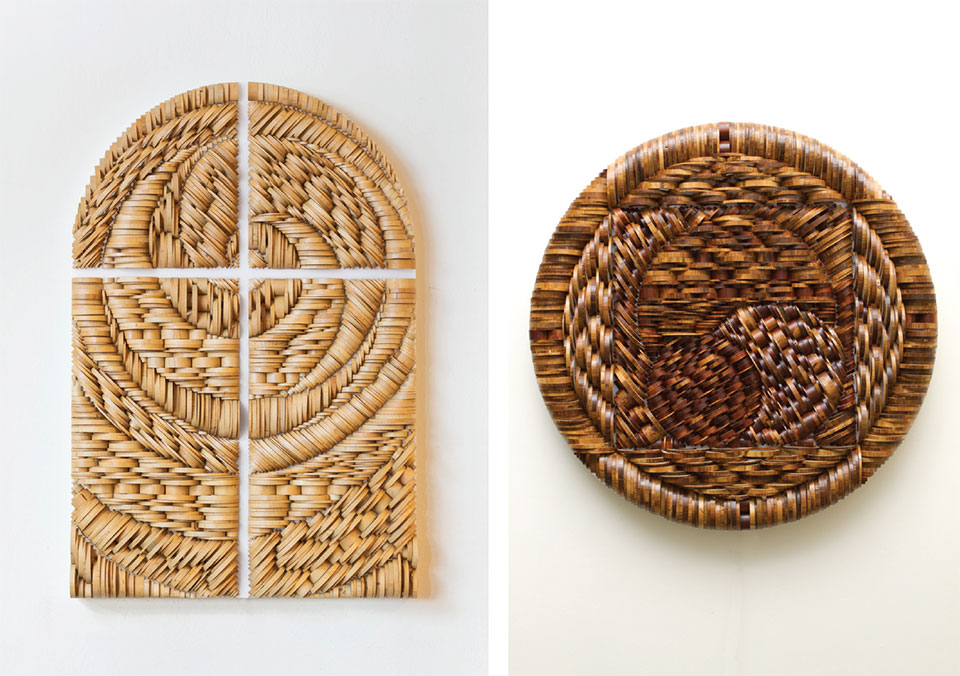
Left: Awakening Luminary: Gratitude to Tadao Ando’s Church of the Light | 52.5” x 35” x 5” | crosscut bamboo, acrylic, wood, and LED lighting.
Right: Ensō Luminary: A Sense of Awareness | 52.5” x 35” x 5” | crosscut torched and antiqued Japanese bamboo, acrylic, wood, paint, LED lighting
“I created a topography for the interplay of light and shadow, which also interweaves scale and proportion,” the artist says. “I continue to use it, and on a recent trip to Japan, my greatest source of inspiration and my third visit, I took pictures of manhole covers, for example, with ginkgo leaves and cherry blossoms because they represent the beauty of Japanese culture. This aesthetic is everywhere, from municipal and civic structures to the most beautiful art. I recognized that I would experiment with the cross-current cut pattern.”
She adds, “Color is also essential to me, and I have a few pieces of Japanese acrylic made to look like rice paper, which I have incorporated into my art, adding a nice dimension. When I was last in Japan, I also visited the Itoyo stationery store in Tokyo to look for paper and find available patterns. I used the paper as a backdrop and mounted the piece onto a board. It has brought me to another exploration, including a Japanese color pattern.”
“As I assemble the pieces, patterns and rhythms emerge that reflect the interconnection of forces in nature, from microscopic life to wave movement,” she reflects. “Interconnectedness is the source, the revelation, and the energy I seek to express in all my work.”
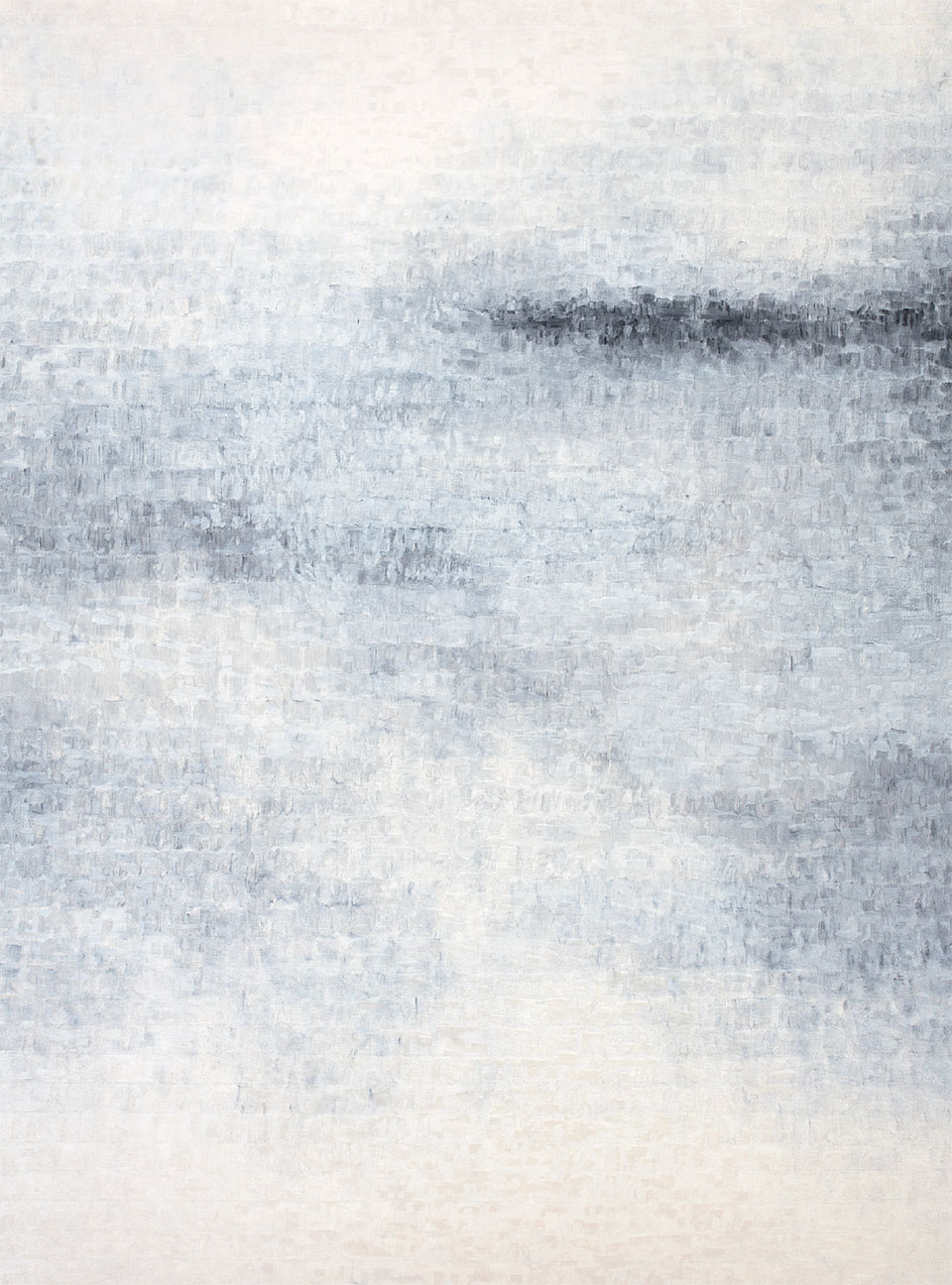
S 357 | 66” x 52” | Oil on canvas | Pegan Brooke
Reimaging Classic Conventions
Gail Severn Gallery
by Lily Martin
“I am awed by the beauty of light falling on water and snow. This visual phenomenon is a perfect natural metaphor for the ever-changing flux in which we make our lives. I love things one can only see for an instant; they shock us into contemplation, thought, and change.”
–Pegan Brooke
The history of art is comprised of various movements and styles, which over centuries has evolved the introduction of new ideas and practices. Pegan Brooke, Maggie Shafran, Betsy Margolius, and Gwynn Murrill are four female artists featured in solo exhibitions this summer at Gail Severn Gallery, who derive inspiration from the past while furthering and expanding upon the art historical canon.
Pegan Brooke’s abstractions on canvas reference 19th-century French Impressionism with an emphasis on reflection and the physicality of each brushstroke – transcending literal representation. Maggie Shafran pays homage to Old Masters painting of the 18th century by deconstructing and reconstructing “the still-life.” Betsy Margolius’s paintings and prints are anything but still. Through the dynamism of her arrangements, she brings pattern, line, and vibrant color to life. Continuing in the long tradition of figurative bonzes, Gwynn Murrill shares an interest in capturing her subject’s true essence through lithe and sinuous forms. Through different mediums, these artists elaborate on conventional styles of impressionism, still-life, and figurative art in an original, contemporary way.
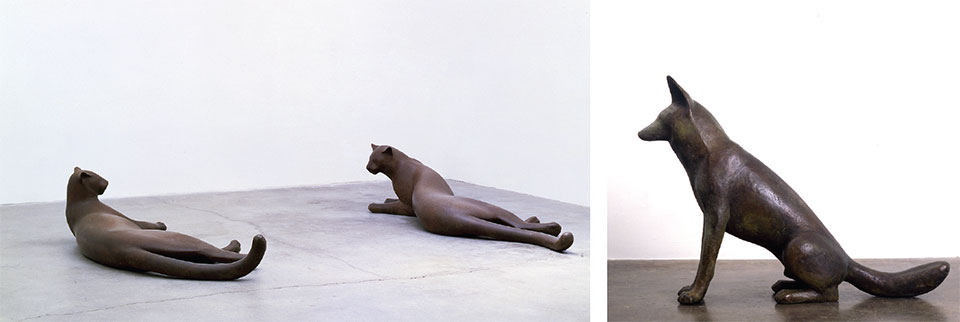
Left: Cougar LA 6/9 | Bronze | 21” x 89” x 34” & Reclining Panther 2/3 | Bronze | 28.5” x 99” x 43” | Gwynn Murrill.
Right: Coyote VI | Bronze | 29.5” x 44” x 10” | Gwynn Murrill
Pegan Brooke is an abstract oil painter working in a minimalist style and monochromatic palette. She mixes metallic pigments in with her medium, adding a rich sheen and texture to each staccato brushstroke. Brooke carefully organizes her compositions into grids, giving structure to hundreds of reflective swaths of paint. These paintings are conceived of with meditative repetition, organically evoking nature’s rhythms and innate patterns. Reliant on perspective, these paintings change in relation to the viewer’s vantage point, time of day, and quality of light. Says Pegan, “I am awed by the beauty of light falling on water and snow. This visual phenomenon is a perfect natural metaphor for the ever-changing flux in which we make our lives. I love things one can only see for an instant; they shock us into contemplation, thought, and change.” This sentiment characterizes the basis of Impressionism, which rejects realistic representation, instead aiming to capture the essence of the subject. Brooke approaches her work with the same impulse to capture fleeting beauty or instantaneous ‘impression.’
Gwynn Murrill’s life-sized bronze sculptures depict regal animals such as horses, bears, coyotes, and eagles. The artist stylizes her subjects into purified forms, emphasizing primal characteristics and transmogrifying each animal’s unique spirit. Murrill simultaneously distinguishes, yet obscures, by sculpting figures that are at once based in realism, as well as being fiercely enigmatic. “My interest lies in using my chosen subject as a means to create a form that is simultaneously abstract and figurative. I enjoy the challenge of trying to take the form that nature makes so well and to derive my own interpretation of it.” Murrill expertly transforms such heavy and static material as bronze, into figures stirred with subtle movement and dynamic energy.
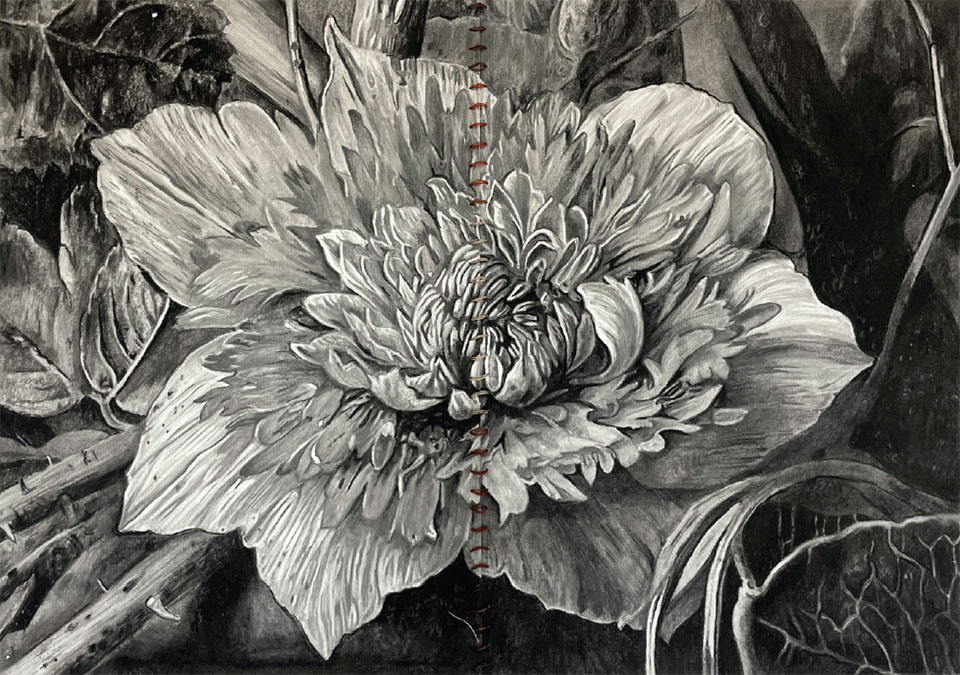
Self pity only gets you more of the same | 14” x 19.75” | Pencil and charcoal on paper | Maggie Shafran
“Similar to the way Jan van Huysum painted flowers in the same vase regardless of the impossibility of their coexistence in reality. With an element of the grotesque residing within the beautiful, his imaginary bouquets are an exhumation and resurrection, a flaunting of art’s resistance to the limits of reality and the confines of impermanence.”
–Maggie Shafran
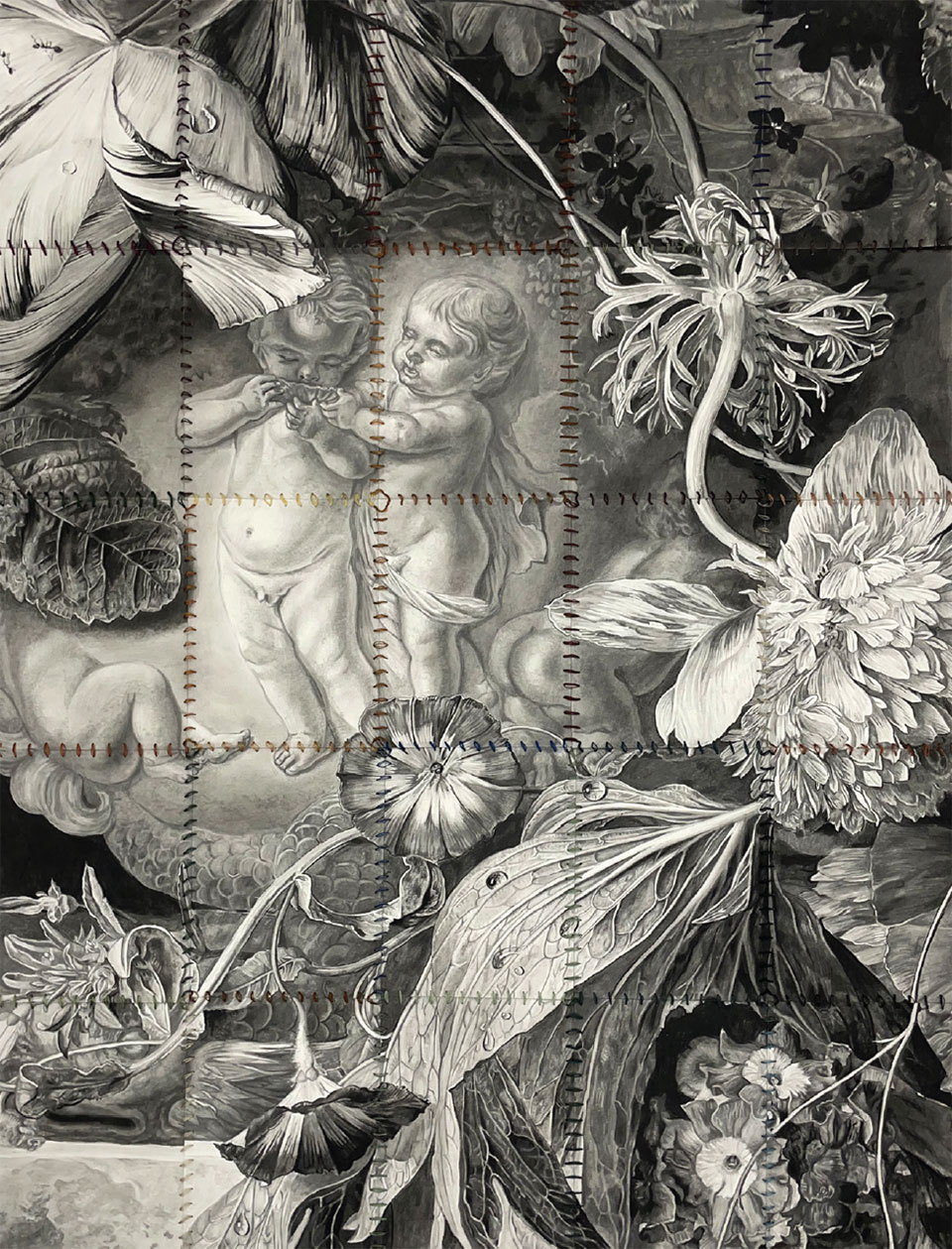
Very little worth knowing is taught by fear | 14” x 19.75” | Pencil & charcoal on paper | Maggie Shafran
Maggie Shafran uses pencil, charcoal, and thread to construct hyperrealist still-life drawings evocative of 18th-century Flemish “flower painting.” Through technical virtuosity and art historical reference, Shafran inserts her own narrative into a long tradition of depicting what is not (or no longer) living and cannot move. Also known as “Nature Morte,” still-life painting can serve to remind the viewer of their own mortality by dramatically emphasizing flowers, plants, or food in the process of decay. “Similar to the way Jan van Huysum painted flowers in the same vase regardless of the impossibility of their coexistence in reality,” Shafran explains. “ With an element of the grotesque residing within the beautiful, his imaginary bouquets are an exhumation and resurrection, a flaunting of art’s resistance to the limits of reality and the confines of impermanence.”
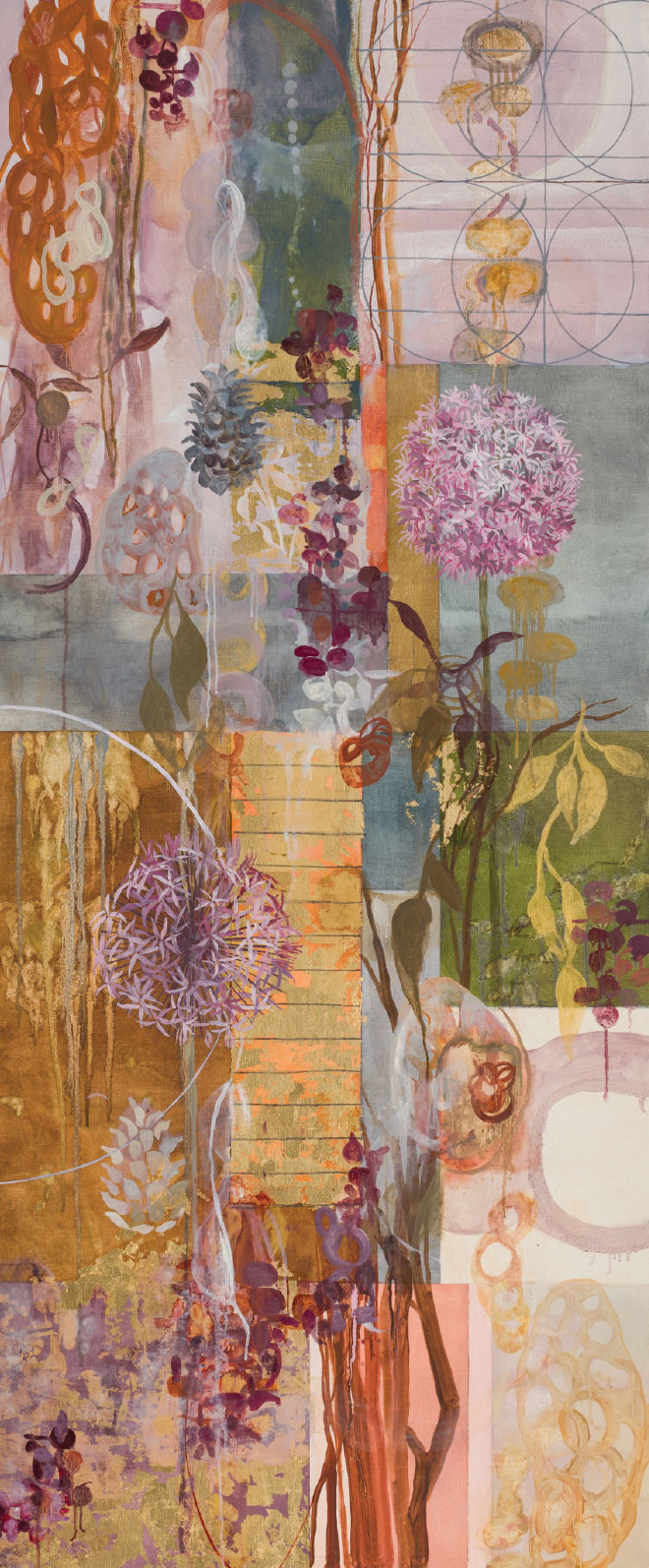
Alium II | 60” x 25” | Oil on panel | Betsy Margolius
Betsy Margolius approaches a similar subject of flora with different impulses and considerations. In a highly saturated, free-form style, Margolius abstracts nature’s many forms and intonations. “I find inspiration in the unique curved line of a rose, the elegance of a tree branch, and the simple organic shape of a stone. My aim is to re-create the endless sense of beauty and wonder that nature provides by layering, juxtaposing, and interweaving one natural image with another,” she shares. Instead of staging her still-life work upon a cloth-covered table in the studio, Margolius collects ideas and visions from the natural world. Her compositions on panel and paper manifest as bouquets of colorful bursts and vibrating floral forms. Margolius creates her own environments and invites the viewer in to awaken their senses.
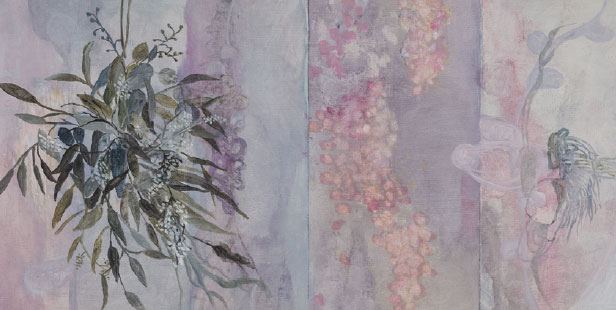
Winter Bouquet VI | 12” x 24” | Oil on panel | Betsy Margolius
Pegan Brooke, Gwynn Murrill, Maggie Shafran, and Betsy Margolius respectively offer a refreshing perspective on classic conventions of art-making. Gail Severn Gallery is pleased to present a new series of work by Gwynn Murrill and Betsy Margolius in July, followed by Maggie Shafran’s and Pegan Brooke’s exhibitions in August. Each show will run the duration of the month and you can inquire for more information at info@gailseverngallery.com or 208-726-5079.
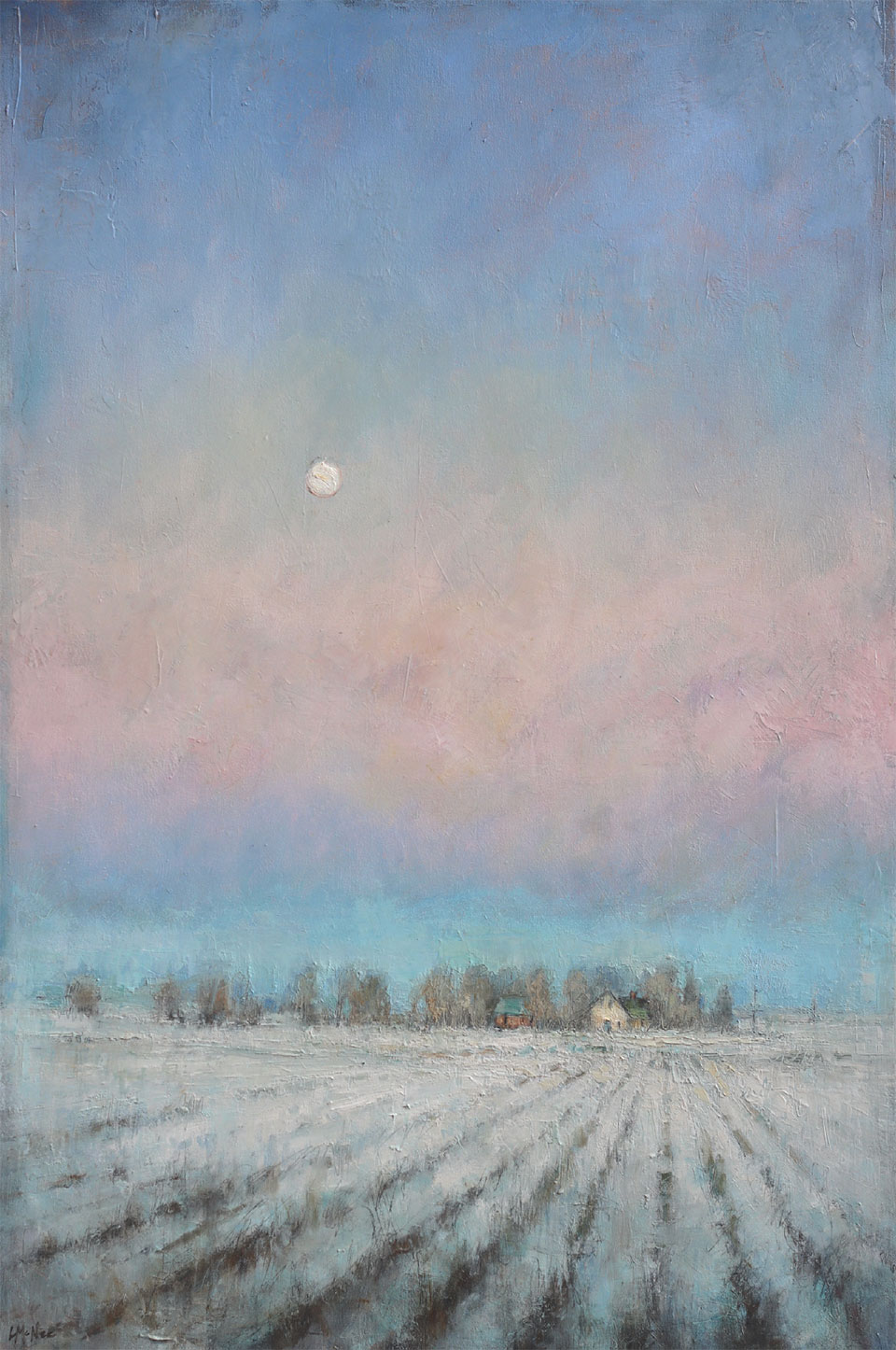
Idaho Glow | 36” x 24” | oil and mixed media on canvas
The Luminescence of
Lori McNee
Sun Valley Artist & Businesswoman
by Sabina Dana Plasse
“When we create, it comes from our heart, is authentic, and translates to others. In a chaotic world, I create a place of solace and quiet contemplation.
I believe my work has a sense of nostalgia and harkens back to when things were simple.”–Lori McNee
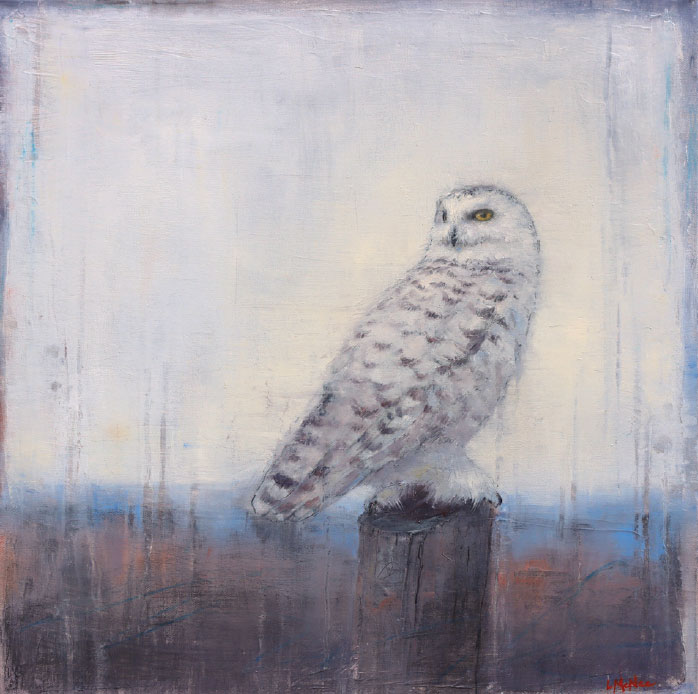
Mystic Guardian | 24” x 24” | Oil and mixed media on panel
From the time she can remember, Lori McNee has always held a pencil in hand. This proclivity has provided her with endless inspiration for works that depict the natural world and the ability to seamlessly translate her experiences into fine art. McNee’s reach is far and lasting through her encaustic work, plein air studies, and studio painting. However, what makes McNee’s works so collectible is the niche she has carved out in a saturated market, clearly defining her perspective and value.
“While depicting beauty in a world where we cohabit, I am always striving to capture the luminosity in nature. I want to illustrate and interpret the landscape and its creatures with the radiance I feel and understand. It is a sense of self that finds a connection when I am out in nature, and it has incredible spiritual meaning for me. I believe this feeling resonates with individuals,” says McNee.
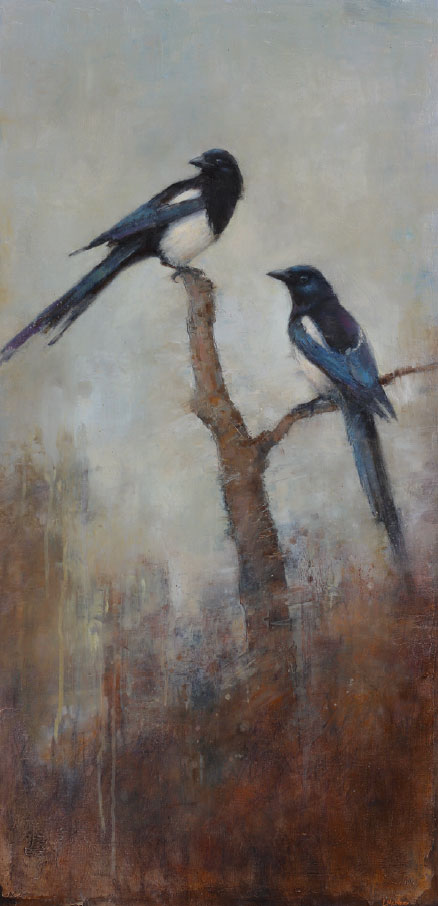
Midwinter Magpies | 48” x 24” | oil on canvas
“The work that I do fills my soul,” she adds. “When we create, it comes from our heart. It is authentic and translates to others. In a chaotic world, I create a place of solace and quiet contemplation. I believe my work has a sense of nostalgia and harkens back to when things were simple.”
In addition to working from a soulful place, McNee is also a businesswoman and an entrepreneur. “I know that for artists to succeed, they need to put on their business cap, which, for many, is not easy to do,” she says. “I also believe that giving back is important to the process, and one that I enjoy most.”
McNee spent the last several decades raising a family and pursuing her career as a working artist in Sun Valley. She is also a Signature Member of Oil Painters of America and the American Impressionist Society, a certified Master Artist in Cobra water-mixable oil paint, and an International Artist Ambassador for Royal Talens. Additionally, she is also a successful published author, brand ambassador, and keynote speaker.
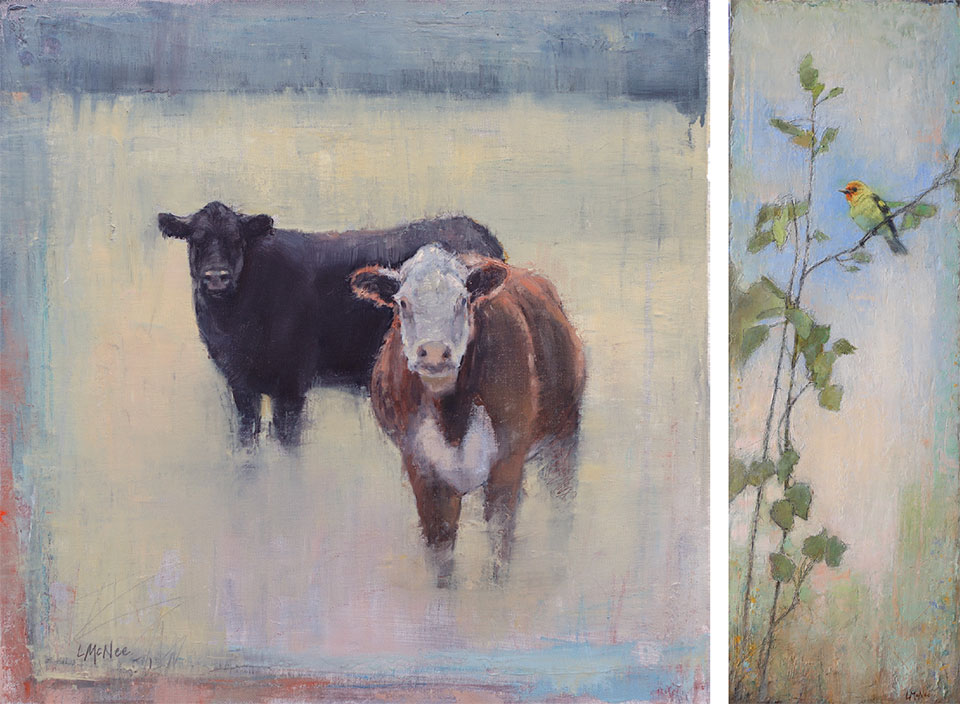
Left: Country Girls | 20” x 20” | oil and mixed media on canvas.
Right: Echoes of Summer | 36” x 12” oil and mixed media on panel.
“I keep this quote in mind: ‘Pitch your tent under the shadow of a great edifice,’ which has had real truth and relevance for me. It does not mean copying or replicating. It’s about inspiration. It provides me with the subliminal context that I try to capture in my work,” says McNee. “I am very cognizant of the thread that exists throughout my work, but I don’t want to be limited, so I try to stay aware and open to new ideas and what’s happening.”
As an international art blogger with a healthy social media following, McNee openly shares her secrets with artists, businesses, and organizations around the world, providing art workshops and art education opportunities. McNee not only knows her subject matter but also has well-developed tools that she implements to bring her canvases to life with beauty and spirit.
Earlier this spring, McNee took a retreat to a family property in southern Idaho. Nestled among citrus greenhouse groves and farmland, this change in location and space inspired new work for McNee. She welcomes this growth wholeheartedly.
“I keep this quote in mind: ‘Pitch your tent under the shadow of a great edifice,’ which has had real truth and relevance for me. It does not mean copying or replicating. It’s about inspiration. It provides me with the subliminal context that I try to capture in my work.”
–Lori McNee
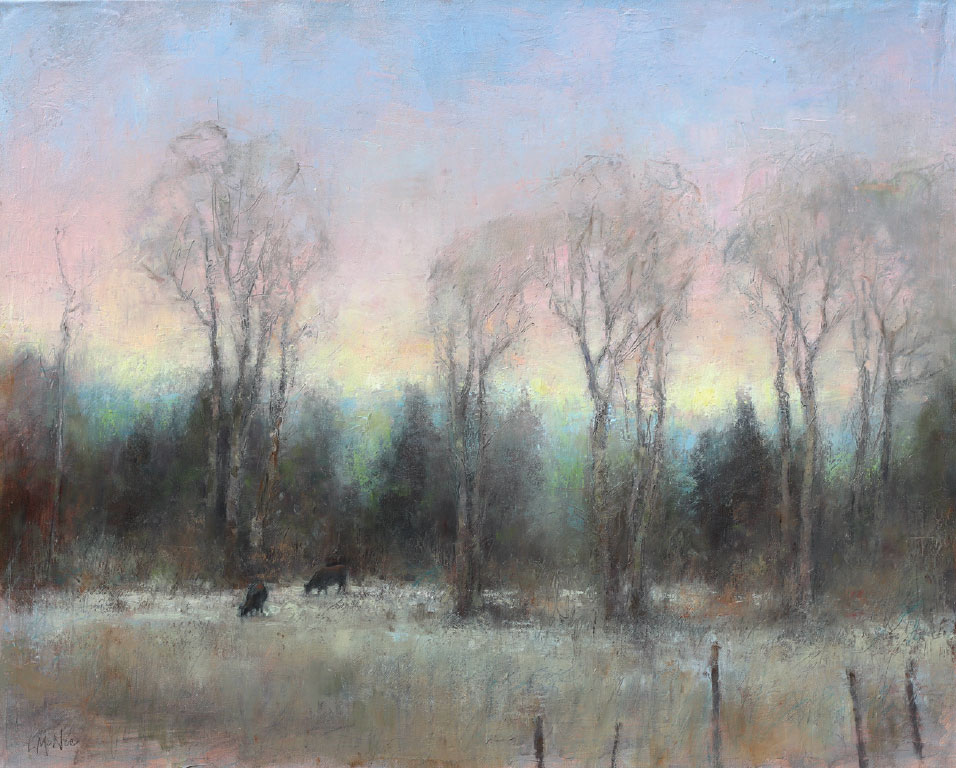
Twilight Grazing | 24” x 30” | oil and mixed media on canvas
“It’s much different from the snowcapped mountains of Sun Valley,” says McNee. “It’s more green grass and blossoms and bees. My time here has allowed me to grow and be flexible, which I fully embody. I will return to Sun Valley later in the summer, but I look forward to splitting my time between these two different landscapes.”
Broadening her scope of work while discovering new trajectories for subject matter and composition, McNee’s latest works reflect her love for the outdoors and her time in Idaho’s south-central mountains near the Big Wood and Snake Rivers. Connecting to the flora and fauna that surround each of these river valleys, McNee’s wildlife and landscape paintings all possess an intrinsic beauty that is unique to these particular Idaho locations.
Through her layers with paint, wax, or mixed media, her composition of space and context, and, of course, her use of color and gradient, McNee offers an ethereal and dreamy, almost somnambulistic world of nature existing in an alternate but beautiful, rich environment that begs us all to visit and stick around in it. Her use of light and contrast brings viewers to an imaginative state of mind. From her still-life work to landscapes and more, McNee has created a world where we can exist every time we glance or stare.
In her upcoming exhibition at the Kneeland Gallery in Ketchum, McNee will present a new collection of pastoral Idaho-inspired landscapes and contemporary wildlife works from her time in southern Idaho. These familiar settings and nature offerings also inspired her to play upon her experience with how light exists and transitions throughout the day in this region of Idaho, showering a viewer or admiring with a fleeting power of presence and the force of nature as if seeing these elements for the first time.
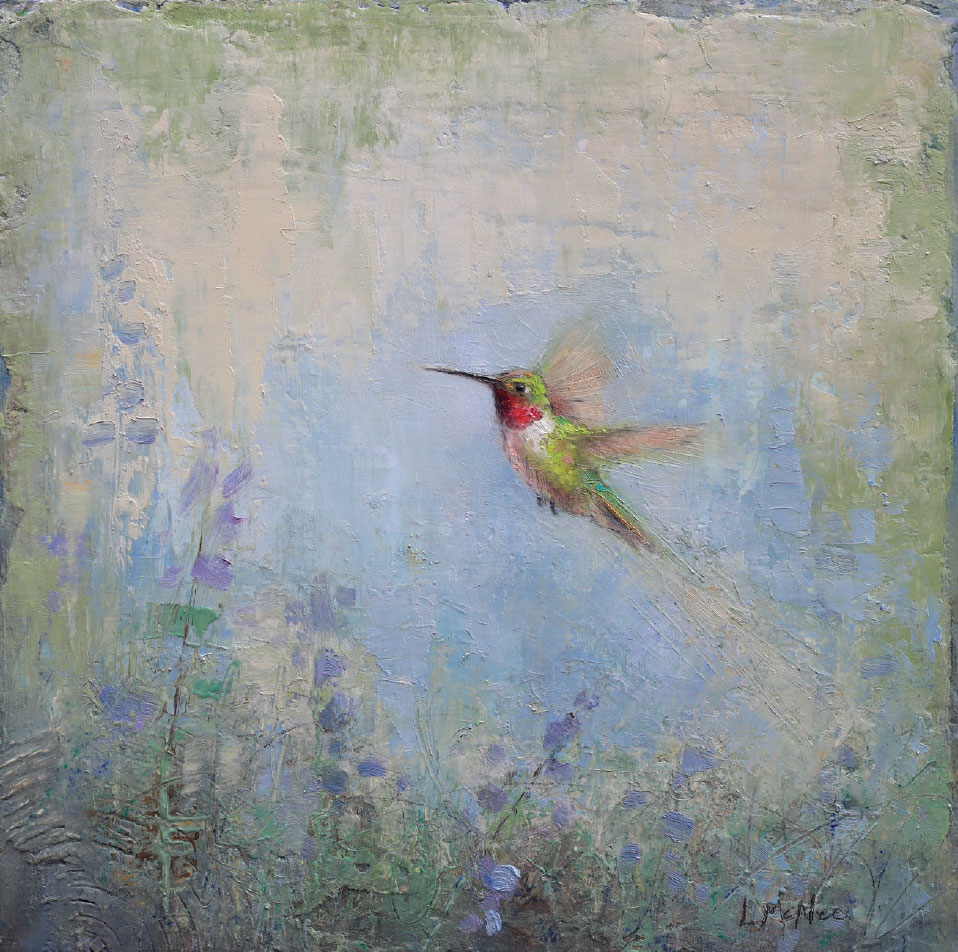
Garden Magic | 12” x 12” | oil and mixed media on panel
Lori McNee on Exhibition
Kneeland Gallery
Artists’ Reception
Friday, July 5, 5-7:30pm
Kneeland Gallery annual Plein Air Exhibition
Friday, August 2
271 First Avenue North | Ketchum
208.726.5512
art@kneelandgallery.com
kneelandgallery.com
Gallery Artist
Dana Gallery
246 North Higgins Avenue
Missoula | Montana
info@danagallery.com
danagallery.com
Martin House Gallery
1098 Main Street
Blowing Rock |
North Carolina
MartinHouseGallery@gmail.com
To learn more about Lori McNee, visit lorimcnee.com.
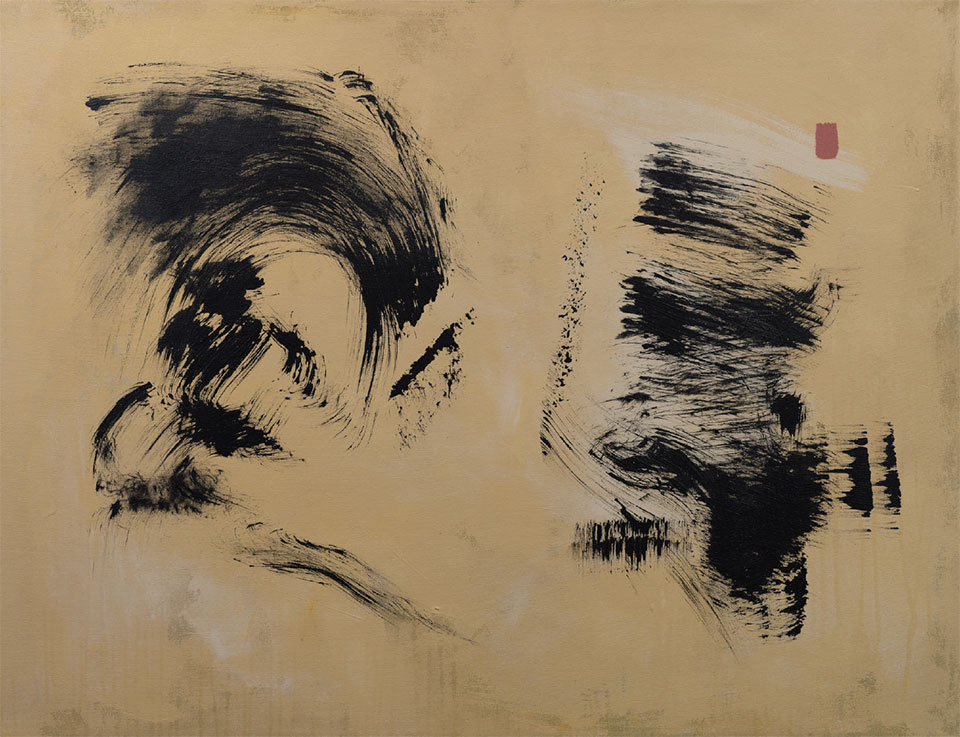
Whisk | 36” x 48” x 2” | acrylic on canvas
Deconstructing Art with
Susan Hall
by Sabina Dana Plasse
“By trial and error, I have learned to overcome a vast expanse of blank canvas by first spraying the canvas with water and then using very diluted paints, spraying and painting with a huge brush, making large random marks that will bleed into the canvas where they will.”
–Susan Hall
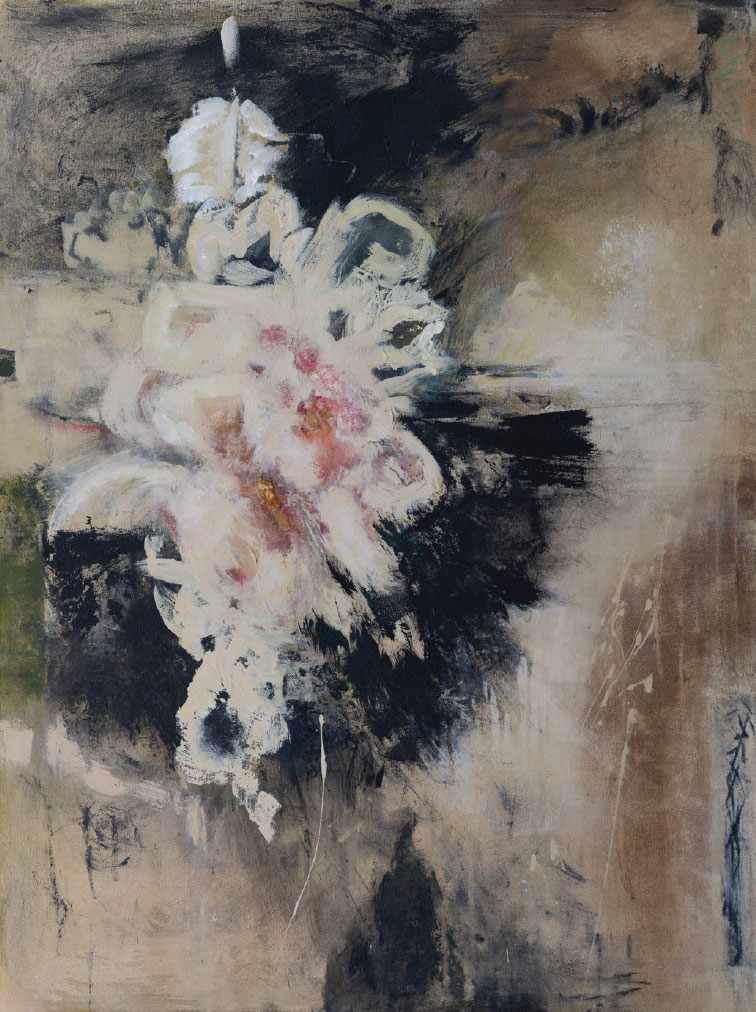
Sky Candilier | 48” x 36” x 2” | acrylic on canvas
Susan Hall is an award-winning artist whose media includes contemporary paintings, fiber, textiles, and ceramics. Well-traveled and well-read, Hall’s dedication to expressing her worldview comes through in her work that balances bold forms and colors with layers of profoundly delicate subtleties.
Hall approaches her painting loosely and lets her large brushstrokes start the discussion. Her use of texture, lines, and color captivates and invites viewers into a meditative space of wonder. Her rich color palettes and sense of style – she is also a successful interior designer – combined with her clear competence with mixed media form a dialogue that she allows to guide her process. Sometimes, that direction can mean physically turning a painting upside-down.
“By trial and error, I have learned to overcome a vast expanse of blank canvas by first spraying the canvas with water and then using very diluted paints, spraying and painting with a huge brush, making large random marks that will bleed into the canvas where they will,” Hall says. “It’s difficult to talk about the substance of one’s own art; every day, a new set of circumstances; every minute in one’s own studio. The time-honored tools and the found objects can be discussed, as can the types of canvas, the paints, the colors, and the composition. The creative process has been dissected into little pieces many times, but we still try.”
“My works mean something different to everyone, which is what art is supposed to do.”
–Susan Hall
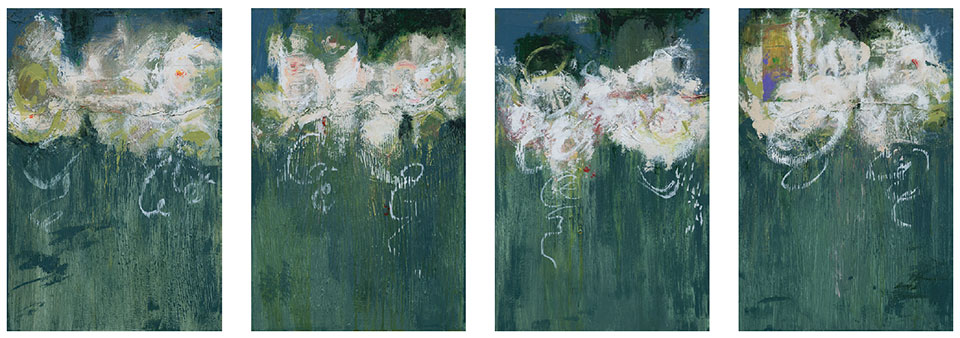
Wisteria Series | 18” x 12” x 2” (each panel) | acryilic collage on panel
Hall’s paintings and mixed-media collages are lush abstract works created slowly and thoughtfully, producing images that are timeless and decidedly contemporary. Working with stretched canvas, on wood panels, or on loosely hung canvas tapestry, Hall applies paints or stains liberally, creating texture and markings to set the mood. She then scrapes away areas and overpaints and continues scraping and painting multiple times.
“The textures, colors, markings, as well as the act of making something imbued with sensibility, keep me painting,” Hall says. “My work is, for the most part, non-figurative and non-representational. It is abstract yet filled with references and history, elusive yet hopefully engaging.”
To take her concepts to their fullest expression, Hall might embellish the work with stitchery and/or collage. The work must be done quickly, as acrylics and watercolors dry rapidly. Color, form, and texture are manipulated until the painting gains a nebulous structure. The work may then be rotated to further enhance the idea or emotion she wishes to convey. No act is complete—finished—until it leaves the studio. Weeks or months later, there may be more additions.
“The creative process is a ‘process.’ It is a series of events leading to a finished work that should stand on its own as a significant entity embodied with enough sensibility to invoke an emotional response in the viewer,” she says. “I need my work to mean something to everyone and have soul. When people tell me I am an abstract painter, it’s not quite right. It’s not splash and dash. It’s very thought-out and carefully planned.”
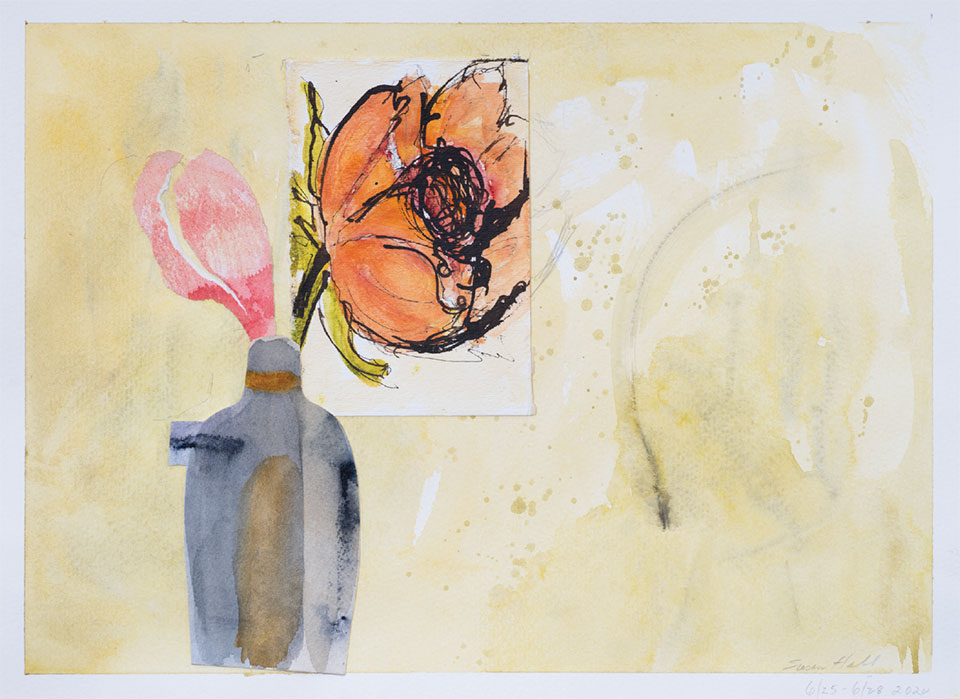
Untitled Flower Collage I | 12” x 16” | mixed media
Hall’s influences include those from Modern Masters of American abstract expressionism, such as Robert Motherwell. “I found that Motherwell spoke about his work in an interesting manner,” she shares. “He had someone ask him what his work really meant. His response was, ‘Well, it represents 10,000 brushstrokes, and every one of them is a decision I had to make. Either the brushstroke was wrong or right, and by the time I am finished, it has to stand on its own, and it has to be an entity on its own.’” Her point begs the question, “What does Hall’s art mean?” Her works mean something different to everyone, which, as she astutely observes, is what art is supposed to do.
Hall understands art from concept to exhibition. She also understands how to place it in a space. Her knowledge is expansive, as is her ability to connect fine art to the world. As a notable interior designer, Susan Hall also launched her very successful Farm House collection that includes home furnishings and décor that she designs and produces.
“I want the stillness in my work to have an energy behind it; It should still have an intellectual appeal.”
–Susan Hall
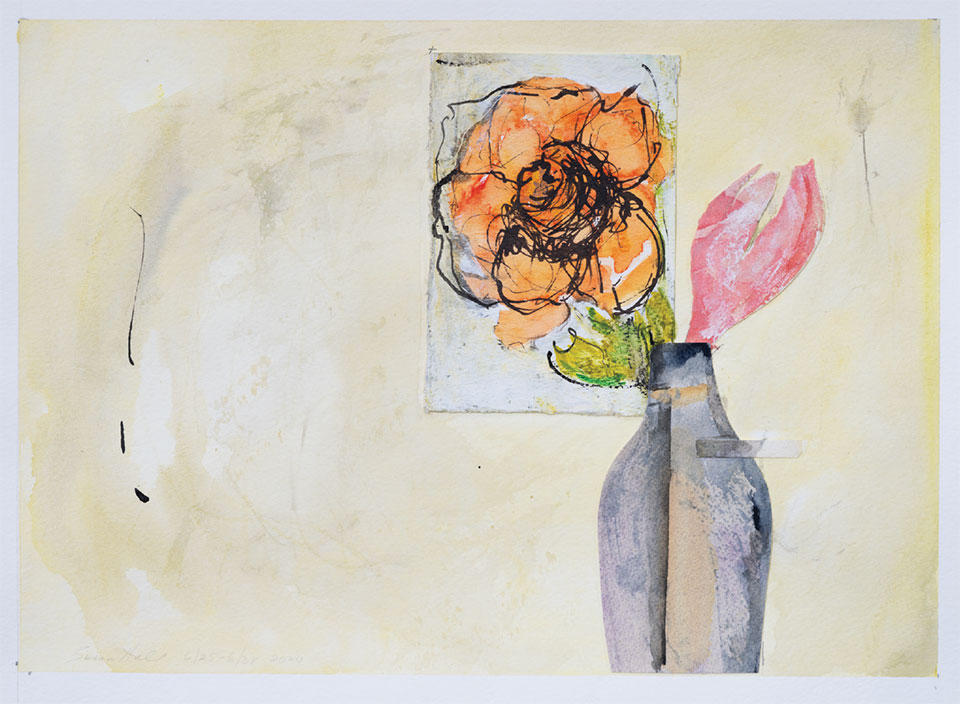
Untitled Flower Collage II | 12” x 16” | mixed media
“I have been in a unique position as an artist,” says Hall. “My career as an interior designer and a fine art artist allows me to assist clients in selecting artwork and to work with architects, builders, and other designers.”
Having traversed both sides of the art world, creating and acquiring art, Hall has had the privilege of collaborating with esteemed designers and architects not only in Sun Valley but also across the Western states.
Commissions, sales, and site-specific art keep Hall very busy. Continuing to sell works as she has for the last 40 years, Susan finds her art as her own life-support. Her favorites hang in her beautifully orchestrated living space, which is filled with thoughtfully selected furniture and décor, as well as her collection of art books. Like her reference library at home, and undoubtedly an influence from her experience as an art educator, Hall works with the intention that viewers read her paintings over and over again, finding a connection that invites a studious return to her paintings while building their own understanding of her work.
“For me, that constitutes a real emotional work of art,” she says. “I want the stillness in my work to have an energy behind it; It should still have an intellectual appeal.”
“My career as an interior designer and a fine art artist allows me to assist clients in selecting artwork and to work with architects, builders, and other designers.”
–Susan Hall
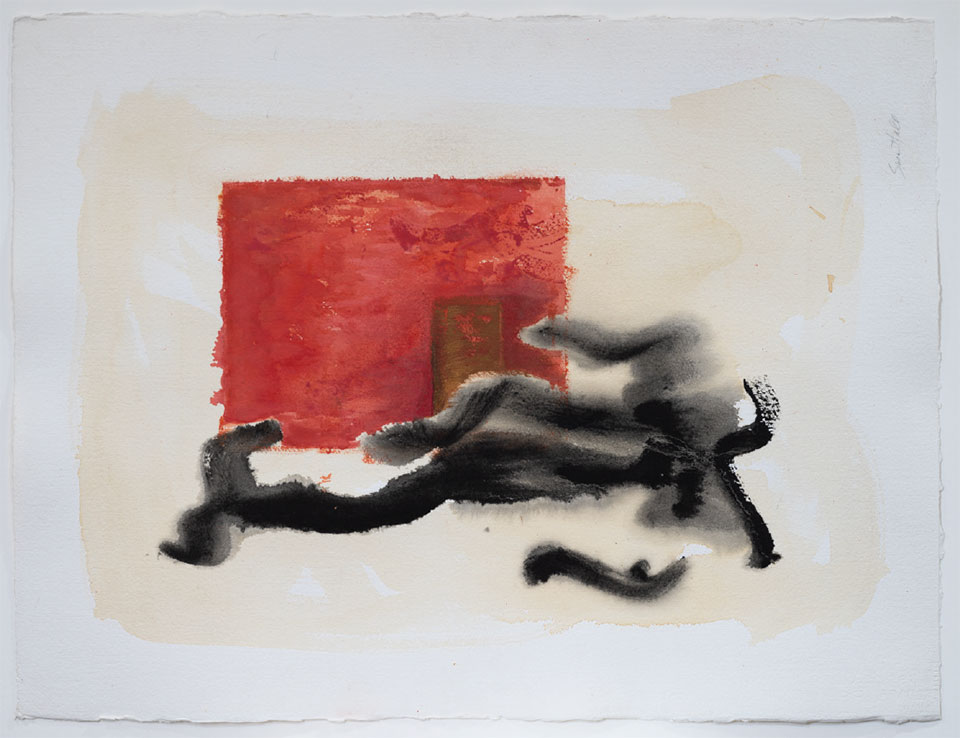
Coupling | 23” x 30” | acrylic in on paper
susanhalldesign7@gmail.com | susanhallartist.com
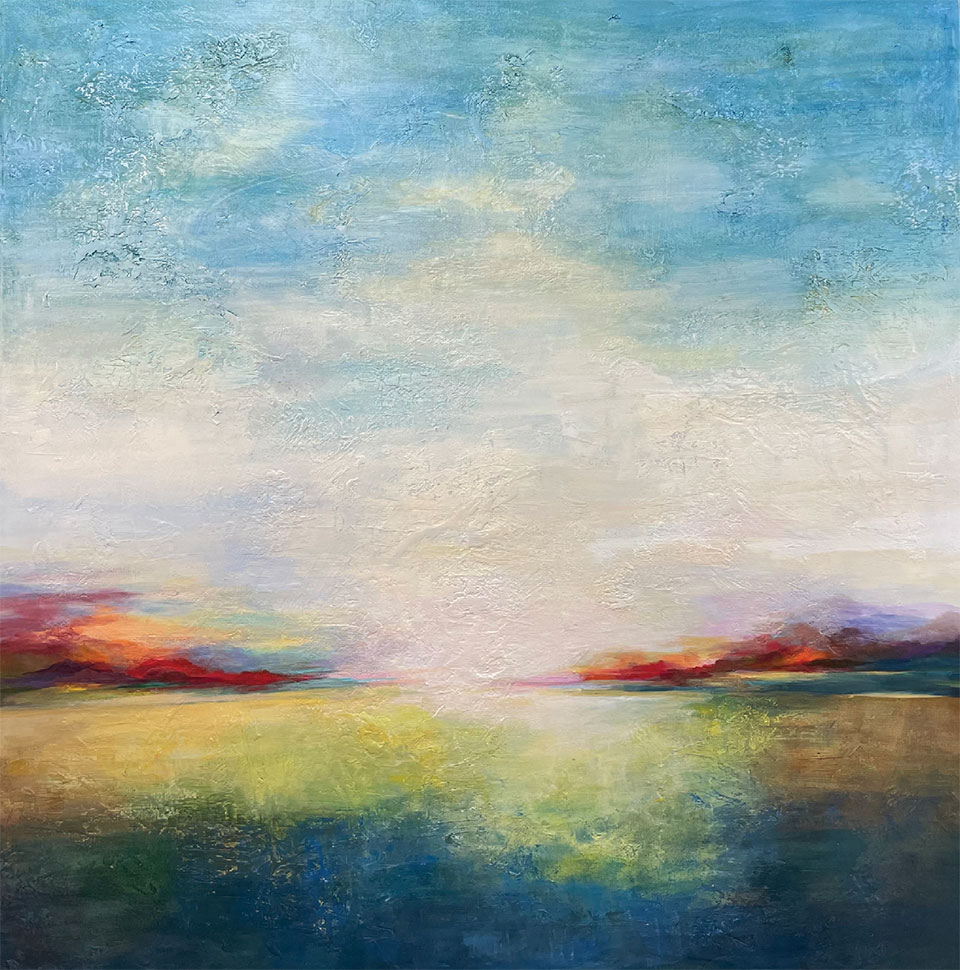
Prairie | 60” x 60” | mixed media on canvas
Driven by creative instinct
Sarah Davies
offers solace in art
by Sabina Dana Plasse
“I love the idea of creating a visual refuge of truth and beauty.”
–Sarah Davies
After receiving a degree in fine art, Sarah Davies continued to follow her passion for painting when a freelance job became a 20-year career as Nordstrom’s Fashion Director. Although Davies had a fulfilling job that she enjoyed, she never lost sight of her desire to paint.
“Whenever I had time, I would paint,” she says. “My job was very creative where I had a significant role and was part of an innovative team. There’s a great deal of expression within the fashion world, and the art and fashion worlds feed one another. I was also exposed to much of what was happening in the art world, such as researching cultural trends and forecasting how they influence the fashion world, but I always painted too.”
Although Davies still monitors trends, her passion is more focused on what nature creates, from wildflowers to forests, and the impression it leaves. She also often works with other artists and participates in group workshops or private instruction.
“Our valley’s open skies and the influence of space live in my psyche along with the many car trips…The visual memories of interesting shapes and colors appear in my paintings as a kind of unplanned documentation of the past.”
–Sarah Davies
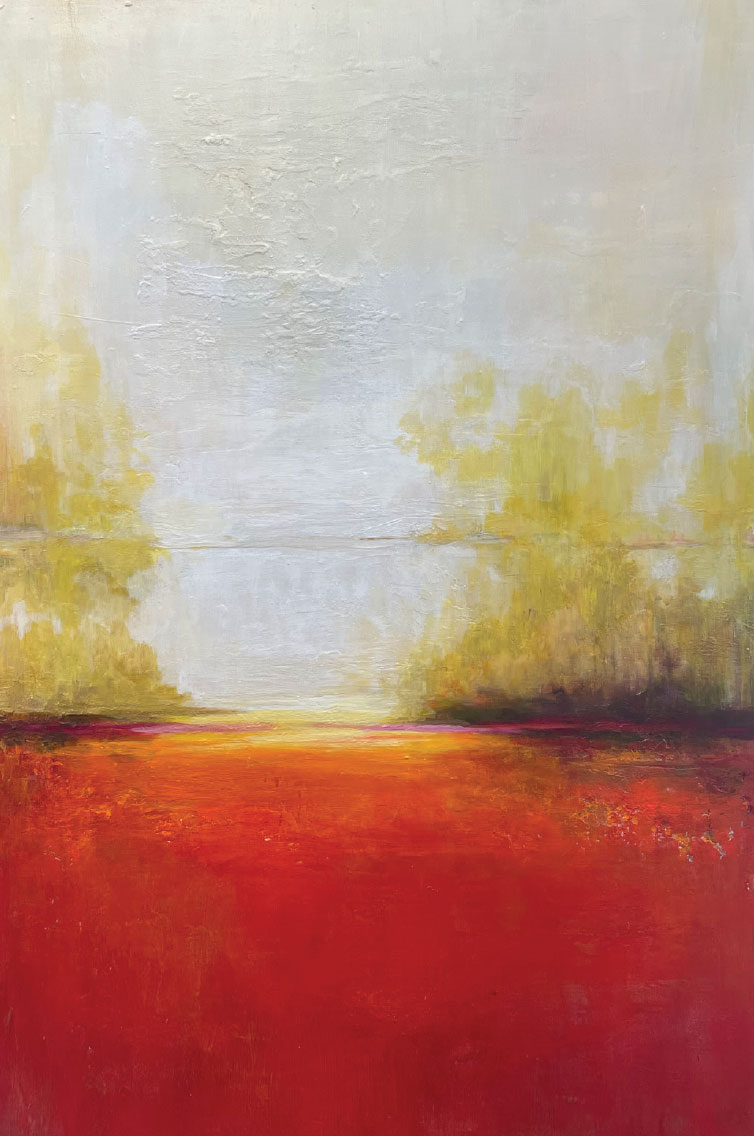
Untitled | 36” x 24” | mixed media on board
“In the Wood River Valley and the surrounding areas, I have found that artists support each other,” she says. “Our creative community inspires me and is why I love working here. It’s similar to the artist communities of the early 20th century.”
Davies has lived part-time and full-time in the Wood River Valley for over two decades. The area is a pronounced influence in her work that focuses on abstract landscapes. Her use of space, especially the large regions of the sky, provides room for exploration and discovery about the natural world.
“Our valley’s open skies and the influence of space live in my psyche along with the many car trips, throughout my life, from California to Idaho across the huge expansive desert landscapes where there was always beauty off in the distance. These journeys have been a distinct part of my work,” she says. “The visual memories of interesting shapes and colors appear in my paintings as a kind of unplanned documentation of the past.”
Beginning with a photograph, Davies references her experience in dramatic natural landscapes and the elements she captures from light, shadows, and haze. As she works to provide a connection between spectral and reality, what emerges is a beautiful place of rest and meditation. Her use of color and elements of mixed media are purposefully constructed to offer a mindful moment of reflection—ethereal distortion and expressionistic color working in unison.
Using an additive and reductive process with combinations of paint, mediums, and textures often informs the direction of the work. This method of sanding, adding layers, and repeating the process is part of Davies’ ability to create a subtle approach and engage the viewer.
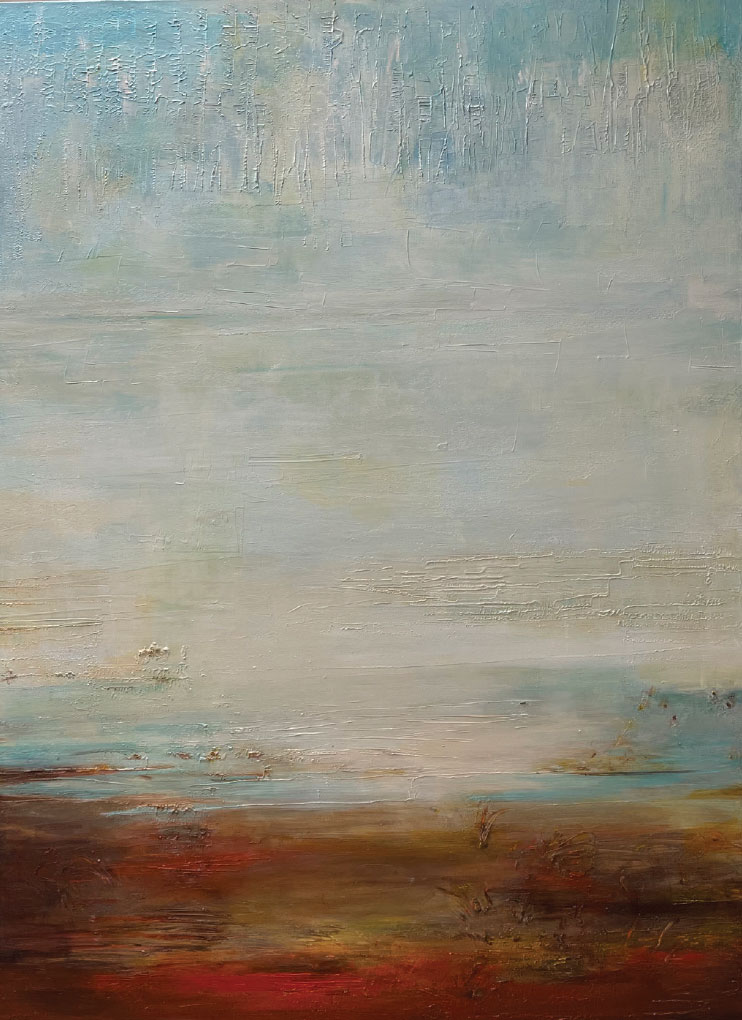
River | 48” x 36” | mixed media on canvas
Adding to her sense of place, especially in the West and the Wood River Valley, Davies refers to a quiet quality around her that motivates her as an abstract landscape artist. “The community is enriched with amazing people who have a level of sophistication that is often highly underrepresented in who they are and what they do,” she says. “This provides a type of energy that lives in this valley, and it rubs off on all of us. I am also encouraged by fresh new ideas from young talented people moving into the community.”
Inspired to push her artistic limits and continue to strive for accomplishment, Davies is an antenna for discovery, knowledge, and observation. She produces art that draws and lures a viewer because it is familiar yet oddly surreal in its existence. She offers comfort and solace in a setting we aspire to be in when reality is less appealing.
“My experimental paintings, which are also mixed-media, combine a desire to call attention to the continuing damage done by plastic bags to the outdoor world. My challenge is to try to create something beautiful by using the bags to create beautiful texture and shapes by adding them to the canvas and then painting over them,” she says. “It’s the attempt to take something ugly and threatening and turn it around to make it part of a thing of beauty. It’s the challenge I have with myself regarding plastic bags.”
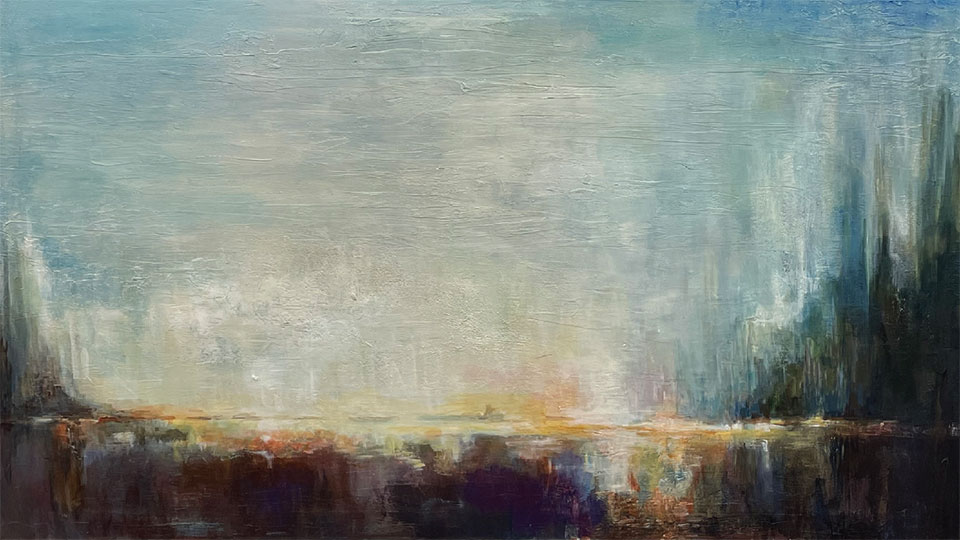
Forest | 36” x 70” | mixed media on canvas
“My work is intended to create a visual refuge of beauty and emotion. It is intentionally subtle, hopefully blurring the lines between reality and abstraction. Creating something beautiful can often make as big a state-ment as something controversial.”
–Sarah Davies
The fragile mountain experience in its current state is at the heart of Davies’ work. She is receptive to the balance of people and nature. “The natural world is so pleasing to me,” she says. “The synthetics that are created, used, and issued in our daily lives, and natural occurrences that are blowing up our world are of grave concern to me. The beauty is fleeting, and I am terrified of losing it.”
“I’m more aware and changed when interacting with the real world, whether it’s a small town in the middle of the desert or living in the Wood River Valley,” she adds. “That awareness provides texture and substance with the desire to preserve places as they are and to keep them precious.”
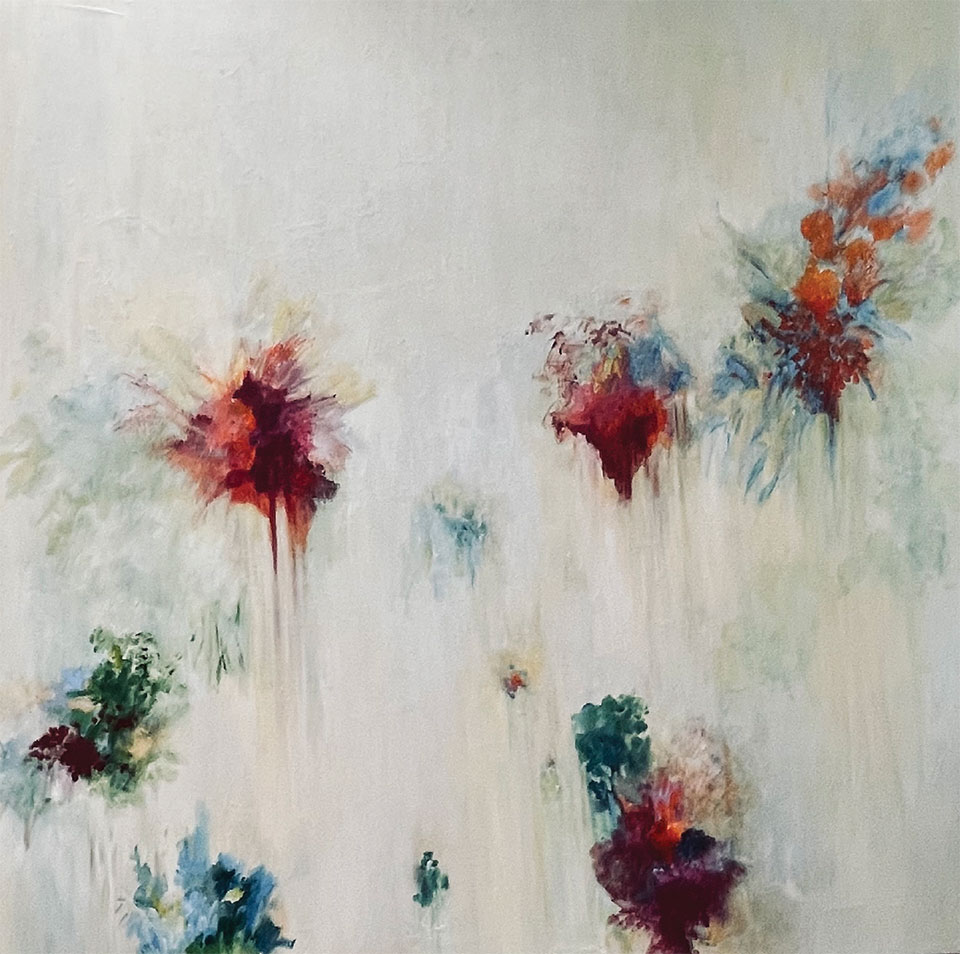
Celebration | 60” x 60” | mixed media on canvas
Davies’ use of color within her contemporary design is mesmerizing. She hopes that viewers become lost in their thoughts when taking in her work, finding places the eye can rest but without any specific directive. Something new is always waiting to be found.
“In today’s art world, there is a lot of political expression,” she says. “My work is intended to create a visual refuge of beauty and emotion. It is intentionally subtle, hopefully blurring the lines between reality and abstraction. Creating something beautiful can often make as big a statement as something controversial.”
sarahdaviesartist.com | sarahdaviesartist@gmail.com | 206.910.1627
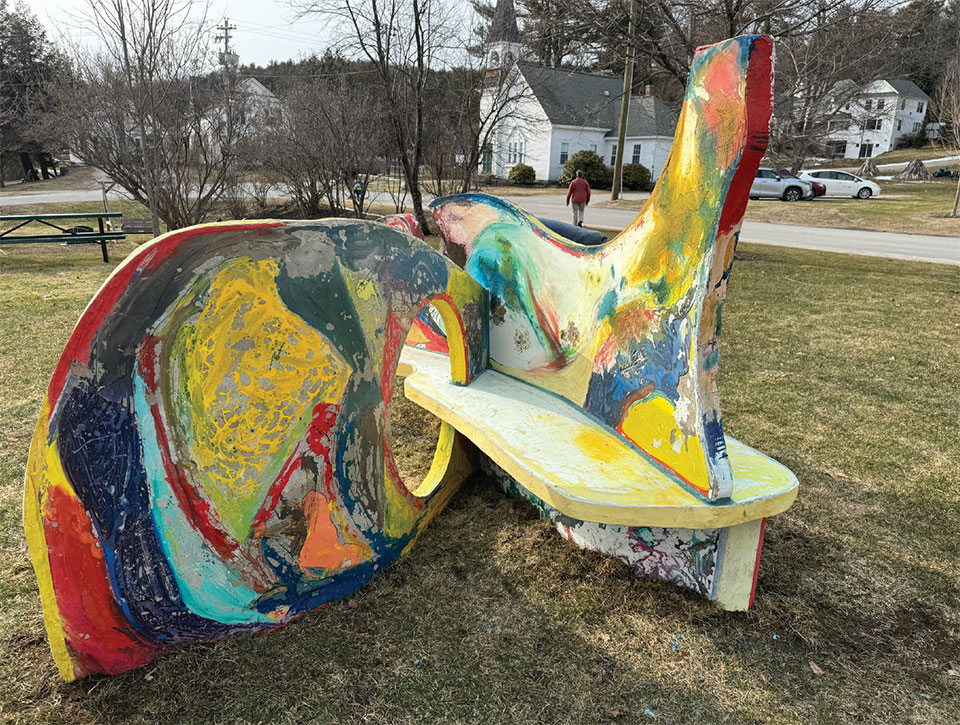
Ocean Elements | Size 9’ x 8’ x 5’8”
Jon Nasvik
Concrete Art Offering
Beauty and Utility
by Sabina Dana Plasse
Inspired by nature, the freedom of design, and imaginative curiosity, concrete artist Jon Nasvik continues to broaden his ever-evolving passion for the medium. Emphasizing the element of discovery, Nasvik’s use of concrete creates varying artistic styles.
For the past four years, Nasvik has worked with students at Proctor Academy in Andover, New Hampshire, a boarding school in the White Mountains. As the school’s resident art teacher, Nasvik is part of a school-wide week of multidisciplinary out-of-classroom experiences. Having created a mural with Proctor students last year, Nasvik returned this year with a different direction in mind and worked with them to create a sculptural bench.
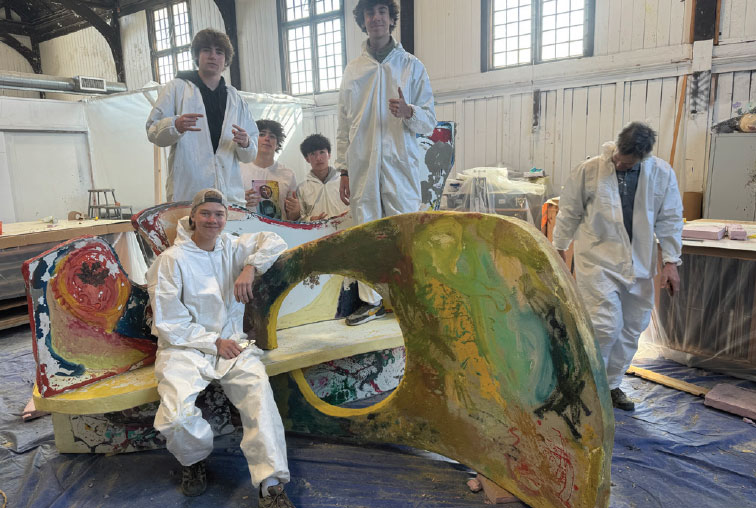
“The bench was intended to be open but divided, so several people could enjoy it without interacting with each other. The sculpture evolved from the idea of an oversized open book to a lower sprawling version that utilized the more interesting elements of the book idea.”
–Jon Nasvik
“The bench was intended to be open but divided, so several people could enjoy it without interacting with each other,” he explains. “The sculpture evolved from the idea of an oversized open book to a lower sprawling version that utilized the more interesting elements of the book idea. We made six separate pieces, three inches thick and large enough to weigh a few hundred pounds each that required invention and creativity when assembling interlocking and bolted parts into a sturdy, safe, and durable public art piece.”
Designed to be open and broad enough for people to sit on, the shape references a Fibonacci Spiral. This spiral became the sculpture’s central piece supporting the bench, ultimately making it attractive and functional. Within four days, Nasvik and five students created a contemporary work of art to accommodate public use on the Proctor Academy campus.
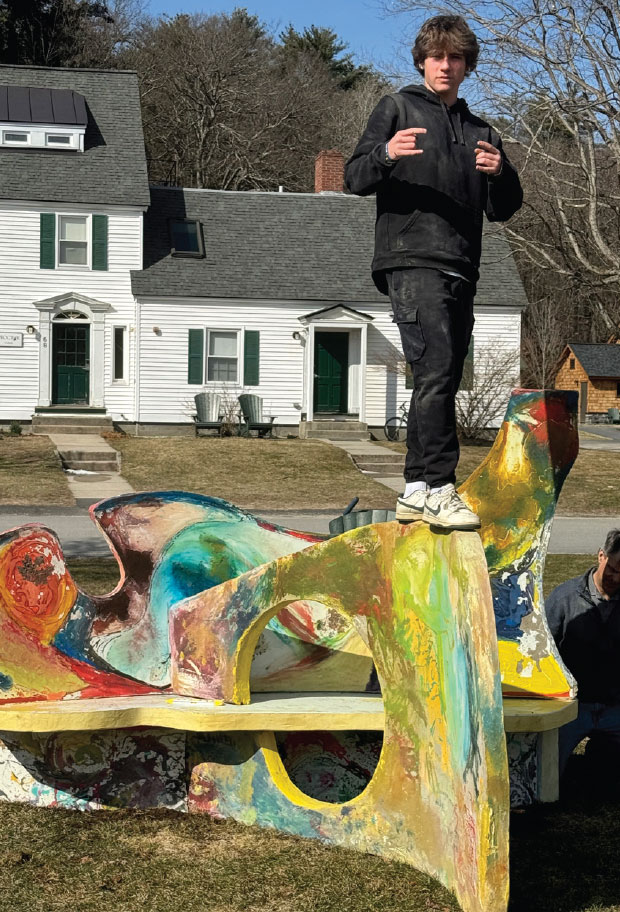
“We made six separate pieces, three inches thick and large enough to weigh a few hundred pounds each that required invention and creativity when assembling interlocking and bolted parts into a sturdy, safe, and durable public art piece.”
–Jon Nasvik
“Those who enjoy progressive and contemporary art appreciated the bench,” says Nasvik. “Overall, it has been well received by the community. It was a wonderful opportunity to lead the design and attempt to balance shapes and color while allowing students to express themselves their own way. I would summarize my experiences at Proctor as adventures in controlled chaos. I have always learned from these educational and exploratory experiences because young, often inexperienced students tend to apply the materials loosely, boldly, and often recklessly. With minimal guidance, the result can be very educational all around.”
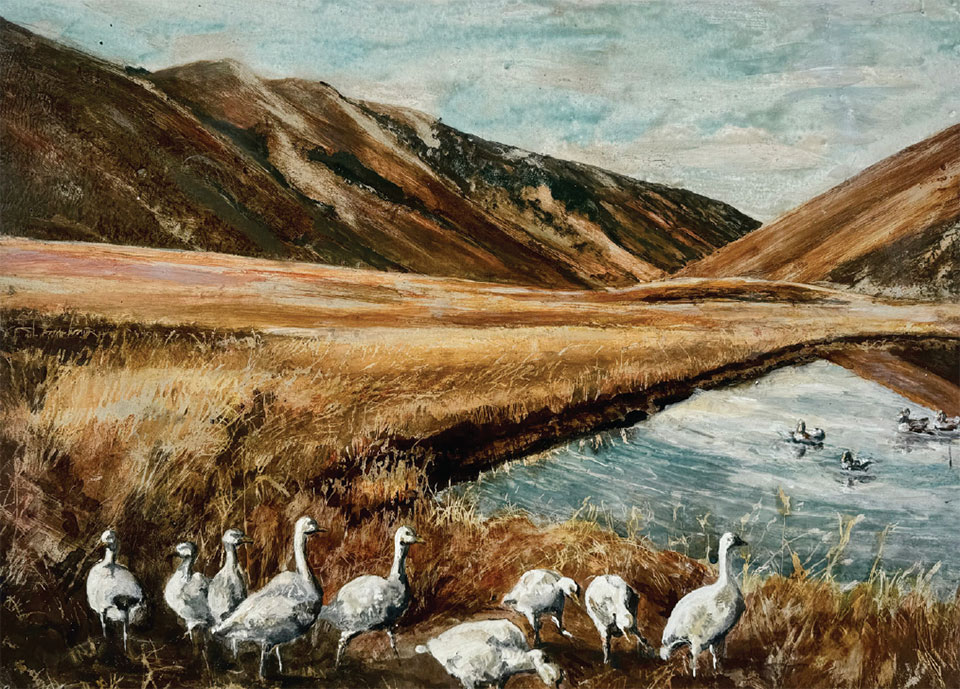
Quigley Pond | 23” x 32”
“There is a misconception that concrete art is heavy, which does not have to be true. Whatever I can do to dispel this and provide support for understanding concrete art as fine art is one of my goals.”
–Jon Nasvik
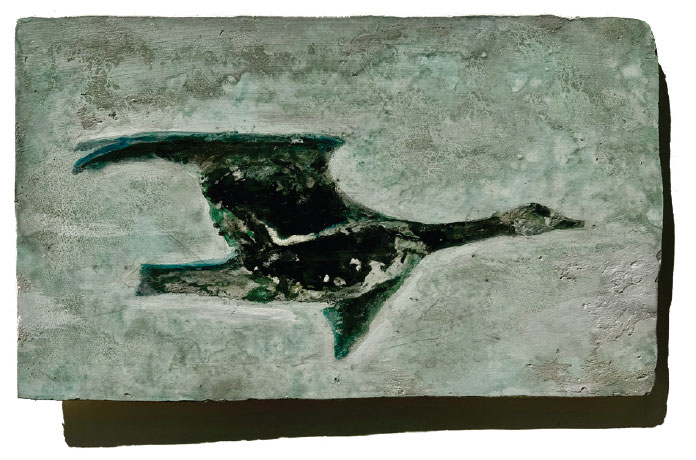
Foggy Flight | 12.5” x 21”
“Working with concrete has come very far for me, especially now that I recognize how much farther it can take me.”
–Jon Nasvik
Nasvik typically expands his horizons with his concrete paintings and sculptures to explore new possibilities for his art. Informing his art, Nasvik’s working world in concrete often includes a variety of sculptures and creative ornamental pieces for luxury homes in Sun Valley and beyond.
Viewers enjoy a tactile experience with Nasvik’s work that is integral to understanding and appreciating concrete art. In his recent works, one can see more energy, detail, color, and vibrancy. Although detail is not always considered, Nasvik makes every effort and consideration to avoid appearing contrived, placing purpose and place as most important. When casting, he adds a wood or aluminum frame within the cement, setting it back behind the polished edges. One only sees the thin edge, so the frame acts as a spacer, causing shadows that float the art evenly off the wall.
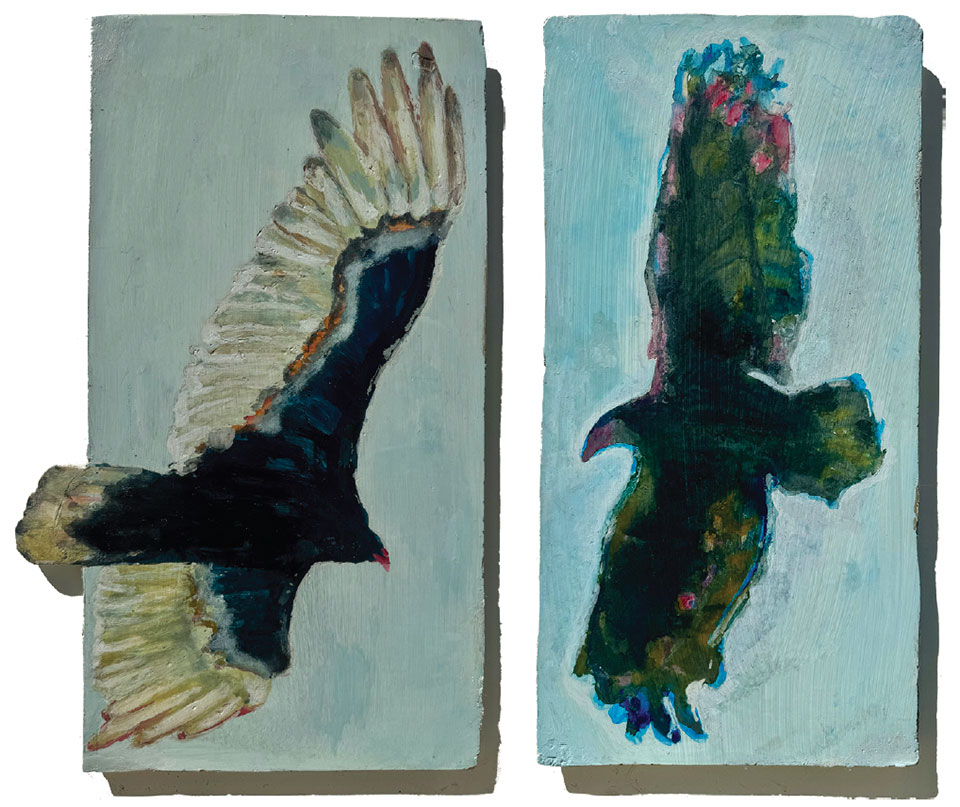
Left: On the Hunt #1 | 12” x 24”.
Right: On the Hunt #2 | 12” x 24”
“I don’t want to frame my work,” says Nasvik. “For me, frames change the character of a piece. I like my art to speak for itself. There is a misconception that concrete art is heavy, which does not have to be true. Whatever I can do to dispel this and provide support for understanding concrete art as fine art is one of my goals.”
With endless potential for discovery, Nasvik understands it takes time for the attraction of concrete art to take hold of someone’s interest. Receiving inquiries from individuals looking specifically for a concrete artist, Nasvik has various projects in the works, from memorials to other commissions including his iconic trees.
“The idea behind the trees is to replicate an aspen concrete forest without limbs,” says Nasvik. “There are 13 of them with details like broken branch stubs and bark texture to greet anyone who comes through the front door. Hopefully, once they are placed, there will be at least one pathway for people to move through.”
Nasvik is excited about the possibilities in sculpture. His work includes commissions by individuals and sculpture for public use. “Working with concrete has come very far for me, especially now that I recognize how much farther it can take me,” he says.
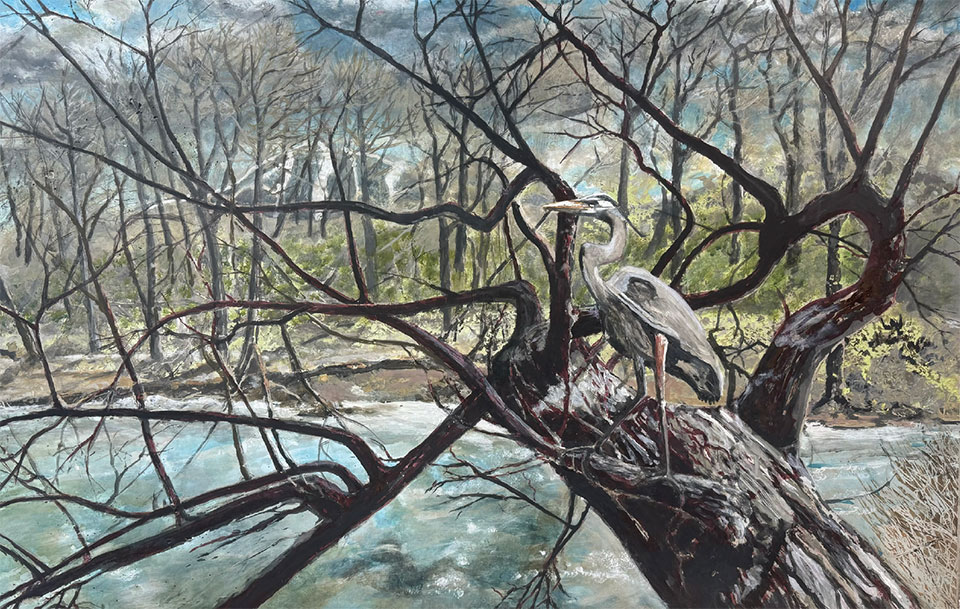
Rainy Spring Morning | 40.5” x 24”
Nasvik adds, “I like to trip outside myself and receive reactions either positive or negative to my work. In some ways, serious opinions, especially from both ends of the scale, suggest that the viewer has been reached… A big part of success comes from sharing.”
jonnasvik.art
Jon Nasvik on exhibition
August, Friday 30
Gallery Walk
5-7:30pm
Anderson Architects
320 1st Avenue North,
Suite 201 | Ketchum
Many Thanks
to our Vibrant Art Community.
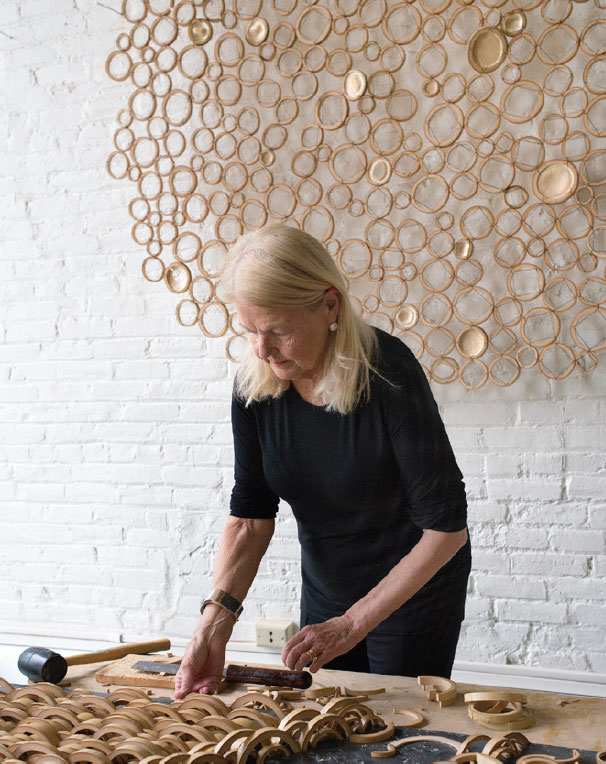
“The interconnectedness of the circle as a universal and enduring symbol is eternal. Bamboo has been used in many cultures for thousands of years, and there is an intrinsic connection between people and bamboo.”
–Anne Crumpacker
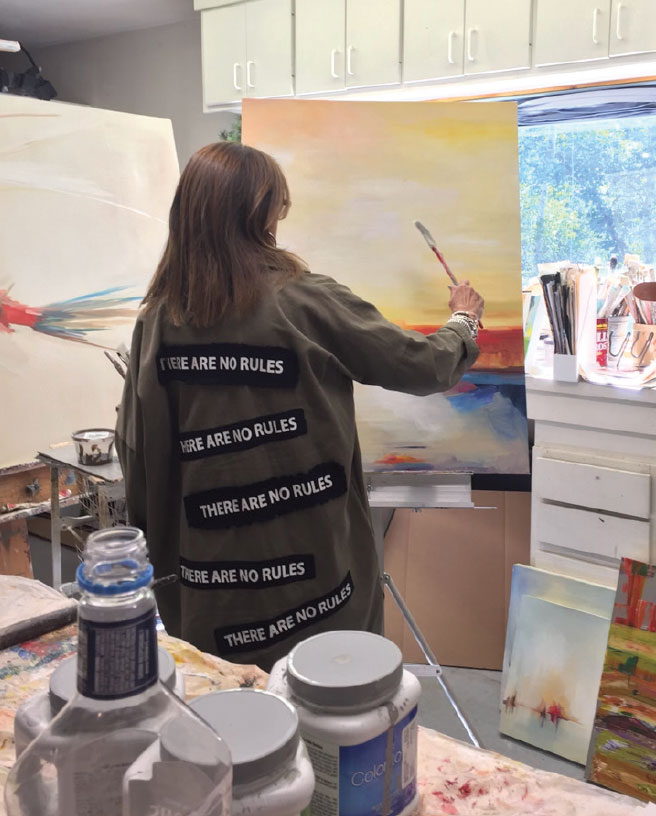
“In today’s art world there is a lot of political expression”. My work is intended to create a visual refuge of beauty and emotion. It is intentionally subtle hopefully blurring the line between reality and abstraction. Creating something beautiful can often make as big a statement as something controversial.”
–Sarah Davies
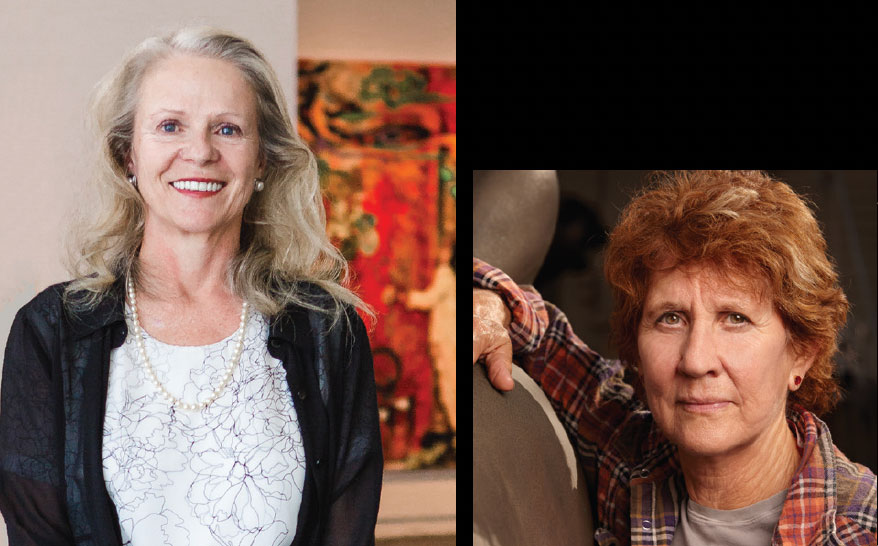
“I enjoy the challenge of trying to take the form that nature makes so well and to derive my own interpretation of it.”
–Gwynn Murrill, Gail Severn Gallery (Pictured Left: Gail Severn, Gail Severn Gallery)
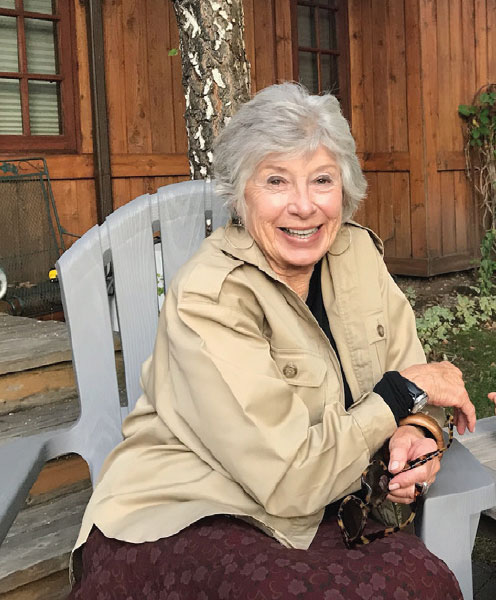
“I found that Motherwell spoke about his work in an interesting manner. When asked what his work meant, he explained that it represented 10,000 brush strokes, and every one of them was a decision he had to make. Either the brushstroke was wrong or right, and by the time he finished, it had to be an entity that stood on its own. Similarly, my work means something different to everyone, which is what art is supposed to do.”
–Susan Hall
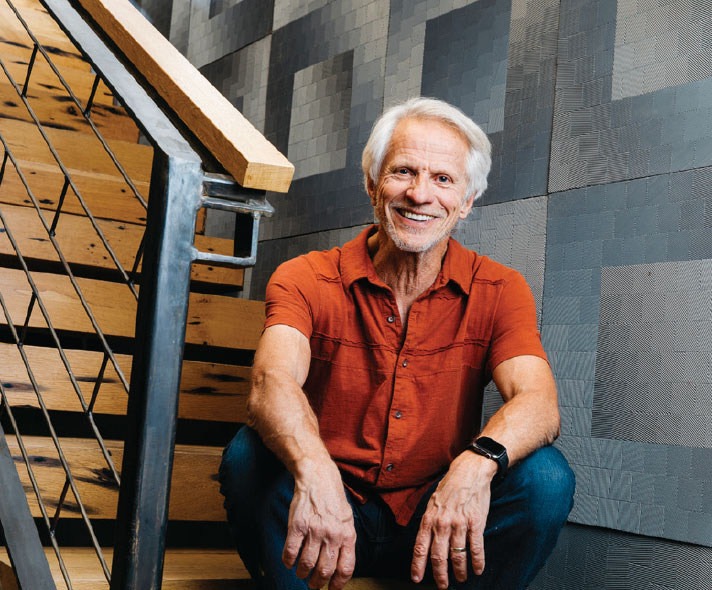
“I like to receive reactions either positive or negative to my work. In some ways, serious opinions, especially from both ends of the scale, suggest that the viewer has been reached…A big part of success comes from sharing.”
–Jon Nasvik
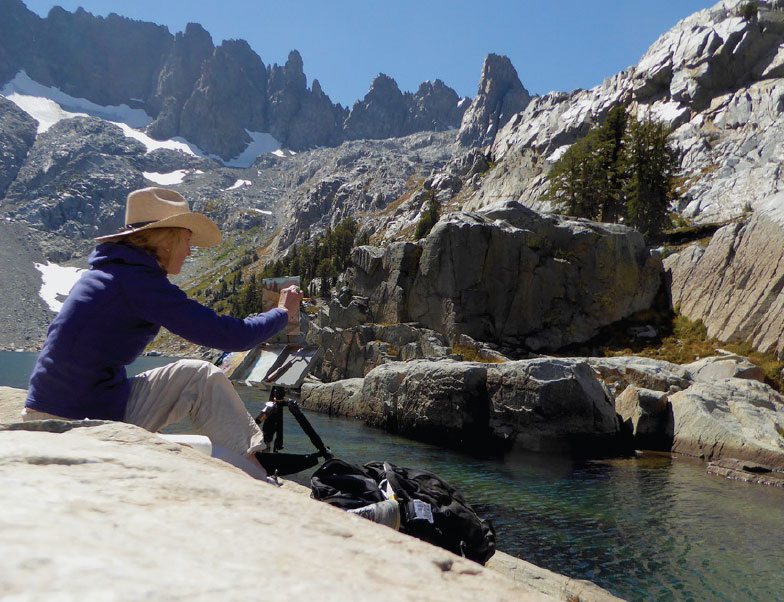
“I am always striving to capture the luminosity in nature. I want to illustrate and interpret the landscape and its creatures with the radiance I feel and understand. It is a sense of self that finds a connection when I am out in nature, and it has incredible spiritual meaning for me.”
–Lori McNee
